Smart Home Technologies for Elderly and Disabled People
VerifiedAdded on 2019/12/04
|44
|12385
|205
Report
AI Summary
. [Online]. Available through:. [Accessed on 11th May 2016].
Contribute Materials
Your contribution can guide someone’s learning journey. Share your
documents today.
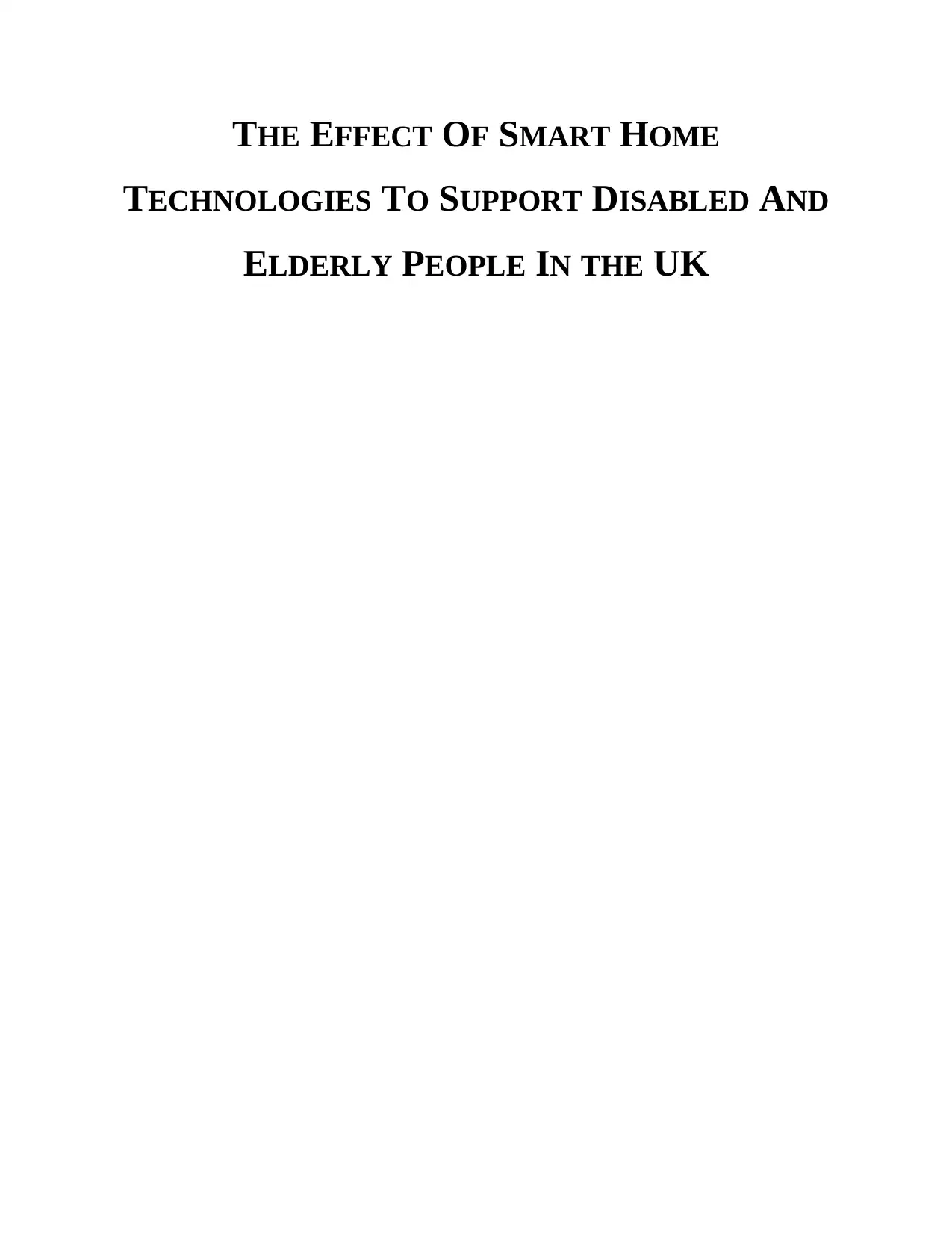
THE EFFECT OF SMART HOME
TECHNOLOGIES TO SUPPORT DISABLED AND
ELDERLY PEOPLE IN THE UK
TECHNOLOGIES TO SUPPORT DISABLED AND
ELDERLY PEOPLE IN THE UK
Secure Best Marks with AI Grader
Need help grading? Try our AI Grader for instant feedback on your assignments.

ACKNOWLEDGMENT
The present report is the significant reflection of the efforts made by various individuals
and this is my responsibility to pay a humble gratitude for their time and efforts they have given
to me. Firstly, I would like to express my sincere gratitude to my advisor, Dr. .............. for the
continuous support, his patience, motivation, and immense knowledge. His guidance helped me
in all the time of research and writing of thankful to all the people who have given me support
and guidance for completing the dissertation. Finally, I must express my very profound gratitude
to my family, especially to my mother, brothers and to my husband for providing me with
unfailing support and continuous encouragement throughout my years of study and through the
process of researching and writing this dissertation. This accomplishment would not have been
possible without them.
The present report is the significant reflection of the efforts made by various individuals
and this is my responsibility to pay a humble gratitude for their time and efforts they have given
to me. Firstly, I would like to express my sincere gratitude to my advisor, Dr. .............. for the
continuous support, his patience, motivation, and immense knowledge. His guidance helped me
in all the time of research and writing of thankful to all the people who have given me support
and guidance for completing the dissertation. Finally, I must express my very profound gratitude
to my family, especially to my mother, brothers and to my husband for providing me with
unfailing support and continuous encouragement throughout my years of study and through the
process of researching and writing this dissertation. This accomplishment would not have been
possible without them.
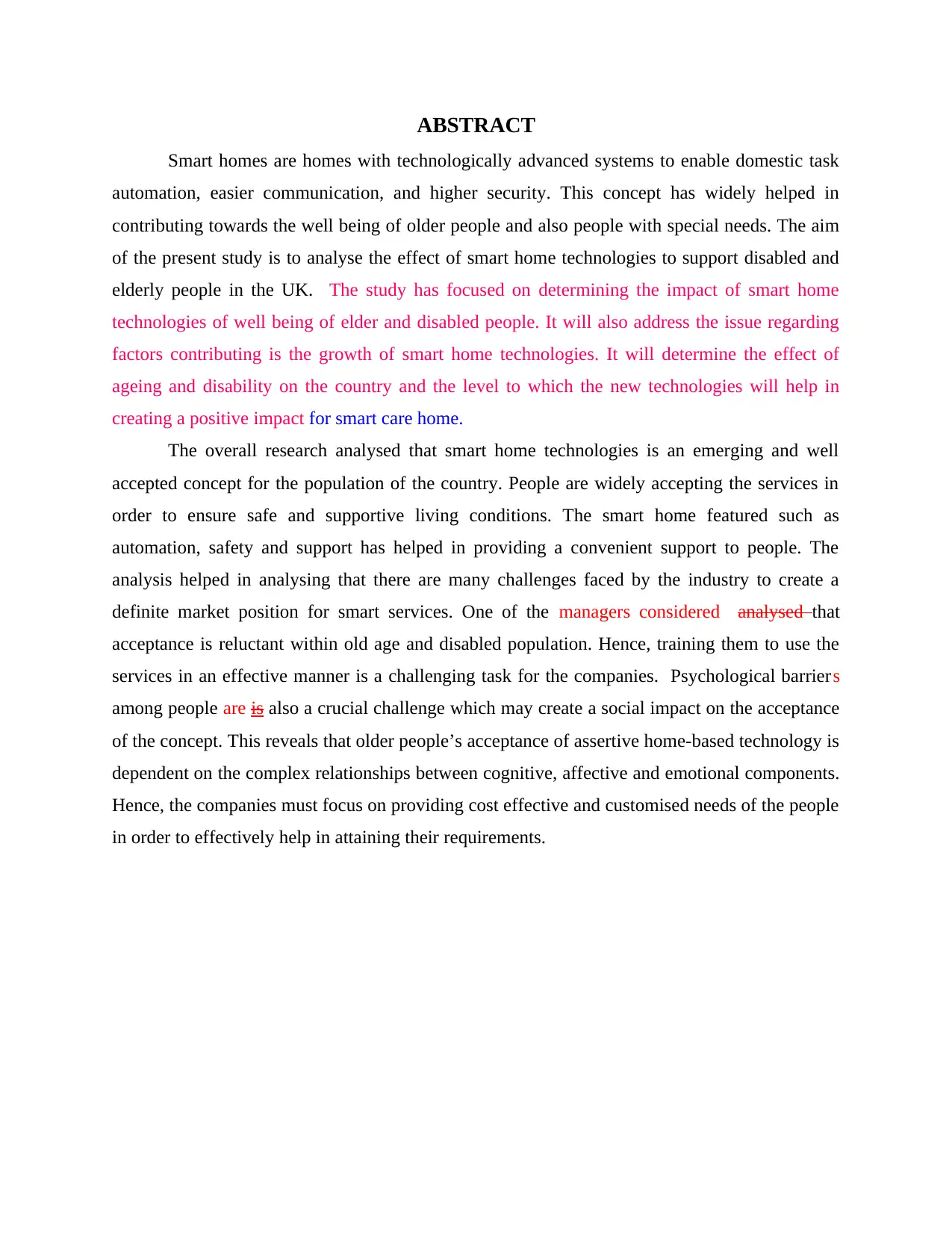
ABSTRACT
Smart homes are homes with technologically advanced systems to enable domestic task
automation, easier communication, and higher security. This concept has widely helped in
contributing towards the well being of older people and also people with special needs. The aim
of the present study is to analyse the effect of smart home technologies to support disabled and
elderly people in the UK. The study has focused on determining the impact of smart home
technologies of well being of elder and disabled people. It will also address the issue regarding
factors contributing is the growth of smart home technologies. It will determine the effect of
ageing and disability on the country and the level to which the new technologies will help in
creating a positive impact for smart care home.
The overall research analysed that smart home technologies is an emerging and well
accepted concept for the population of the country. People are widely accepting the services in
order to ensure safe and supportive living conditions. The smart home featured such as
automation, safety and support has helped in providing a convenient support to people. The
analysis helped in analysing that there are many challenges faced by the industry to create a
definite market position for smart services. One of the managers considered analysed that
acceptance is reluctant within old age and disabled population. Hence, training them to use the
services in an effective manner is a challenging task for the companies. Psychological barriers
among people are is also a crucial challenge which may create a social impact on the acceptance
of the concept. This reveals that older people’s acceptance of assertive home-based technology is
dependent on the complex relationships between cognitive, affective and emotional components.
Hence, the companies must focus on providing cost effective and customised needs of the people
in order to effectively help in attaining their requirements.
Smart homes are homes with technologically advanced systems to enable domestic task
automation, easier communication, and higher security. This concept has widely helped in
contributing towards the well being of older people and also people with special needs. The aim
of the present study is to analyse the effect of smart home technologies to support disabled and
elderly people in the UK. The study has focused on determining the impact of smart home
technologies of well being of elder and disabled people. It will also address the issue regarding
factors contributing is the growth of smart home technologies. It will determine the effect of
ageing and disability on the country and the level to which the new technologies will help in
creating a positive impact for smart care home.
The overall research analysed that smart home technologies is an emerging and well
accepted concept for the population of the country. People are widely accepting the services in
order to ensure safe and supportive living conditions. The smart home featured such as
automation, safety and support has helped in providing a convenient support to people. The
analysis helped in analysing that there are many challenges faced by the industry to create a
definite market position for smart services. One of the managers considered analysed that
acceptance is reluctant within old age and disabled population. Hence, training them to use the
services in an effective manner is a challenging task for the companies. Psychological barriers
among people are is also a crucial challenge which may create a social impact on the acceptance
of the concept. This reveals that older people’s acceptance of assertive home-based technology is
dependent on the complex relationships between cognitive, affective and emotional components.
Hence, the companies must focus on providing cost effective and customised needs of the people
in order to effectively help in attaining their requirements.

TABLE OF CONTENTS
RESEACH AIMS AND OBJECTIVES..........................................................................................1
CHAPTER 1: INTRODUCTION....................................................................................................2
1.1 Background of the study...................................................................................................2
1.2 Rationale of the study.......................................................................................................6
CHAPTER 2 LITERATURE REVIEW .........................................................................................7
2.1 Introduction......................................................................................................................7
2.2 Smart home concept.........................................................................................................7
2.3 Smart home Technologies................................................................................................9
2.4 Advantages associated with smart home concepts.........................................................12
2.5 Impact of smart home technology on older and disabled population.............................14
2.6 Factors contribution towards the growth of Smart homes in UK...................................15
2.7 Challenges in implementing smart home technologies for elderly people of UK. .......16
CHAPTER 3: RESEARCH METHODOLOGY...........................................................................18
3.1 Introduction....................................................................................................................18
3.2 Research Approach ........................................................................................................18
3.3 Research Philosophy......................................................................................................18
3.4 Research Design.............................................................................................................18
3.5 Data collection ...............................................................................................................19
3.6 Sampling ........................................................................................................................19
3.7 Data analysis...................................................................................................................20
3.8 Reliability and Validity..................................................................................................20
CHAPTER 4: DATA ANALYSIS ...............................................................................................21
4.1 Introduction....................................................................................................................21
4.2 Data analysis Questionnaire...........................................................................................21
4.3 Data analysis Interview..................................................................................................25
CHAPTER 5 CONCLUSION AND RECOMMENDATION......................................................30
5.1 Introduction....................................................................................................................30
5.2 Conclusion......................................................................................................................30
5.3 Recommendation to government and companies providing smart home services.........31
RESEACH AIMS AND OBJECTIVES..........................................................................................1
CHAPTER 1: INTRODUCTION....................................................................................................2
1.1 Background of the study...................................................................................................2
1.2 Rationale of the study.......................................................................................................6
CHAPTER 2 LITERATURE REVIEW .........................................................................................7
2.1 Introduction......................................................................................................................7
2.2 Smart home concept.........................................................................................................7
2.3 Smart home Technologies................................................................................................9
2.4 Advantages associated with smart home concepts.........................................................12
2.5 Impact of smart home technology on older and disabled population.............................14
2.6 Factors contribution towards the growth of Smart homes in UK...................................15
2.7 Challenges in implementing smart home technologies for elderly people of UK. .......16
CHAPTER 3: RESEARCH METHODOLOGY...........................................................................18
3.1 Introduction....................................................................................................................18
3.2 Research Approach ........................................................................................................18
3.3 Research Philosophy......................................................................................................18
3.4 Research Design.............................................................................................................18
3.5 Data collection ...............................................................................................................19
3.6 Sampling ........................................................................................................................19
3.7 Data analysis...................................................................................................................20
3.8 Reliability and Validity..................................................................................................20
CHAPTER 4: DATA ANALYSIS ...............................................................................................21
4.1 Introduction....................................................................................................................21
4.2 Data analysis Questionnaire...........................................................................................21
4.3 Data analysis Interview..................................................................................................25
CHAPTER 5 CONCLUSION AND RECOMMENDATION......................................................30
5.1 Introduction....................................................................................................................30
5.2 Conclusion......................................................................................................................30
5.3 Recommendation to government and companies providing smart home services.........31
Secure Best Marks with AI Grader
Need help grading? Try our AI Grader for instant feedback on your assignments.
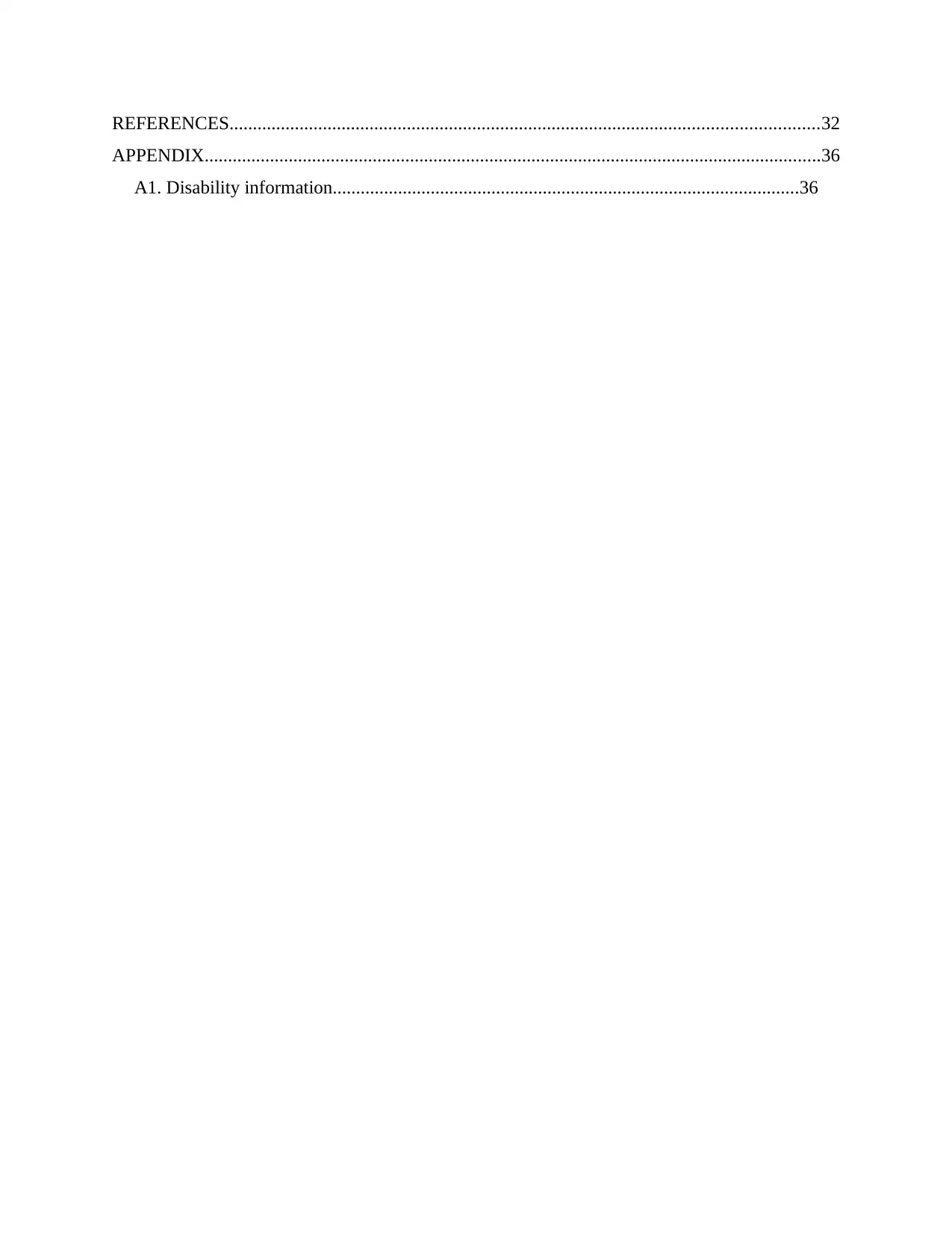
REFERENCES..............................................................................................................................32
APPENDIX....................................................................................................................................36
A1. Disability information....................................................................................................36
APPENDIX....................................................................................................................................36
A1. Disability information....................................................................................................36

RESEACH AIMS AND OBJECTIVES
The aim of the present study is to analyse the effect of smart home technologies to
support disabled and elderly people in UK. In order to effectively attain the stated aim of the
research following objectives will be addressed closely by the researcher:
To review the theoretical perspective and concept of smart home technologies in the UK.
To examine the impact of smart home technology on elder and disabled people.
To evaluate the factors contributing the growth of smart home technologies in the UK To analyse challenges faced by the UK country in implementing smart home
technologies for the elderly people of the UK.
RESEARCH QUESTIONS
What are smart home technologies?
What is the impact of smart home technologies of well being or elder and disabled
people?
What factors are contributing in the growth of smart home technologies?
What are the challenges faced by country in implementing smart home technologies?
1
The aim of the present study is to analyse the effect of smart home technologies to
support disabled and elderly people in UK. In order to effectively attain the stated aim of the
research following objectives will be addressed closely by the researcher:
To review the theoretical perspective and concept of smart home technologies in the UK.
To examine the impact of smart home technology on elder and disabled people.
To evaluate the factors contributing the growth of smart home technologies in the UK To analyse challenges faced by the UK country in implementing smart home
technologies for the elderly people of the UK.
RESEARCH QUESTIONS
What are smart home technologies?
What is the impact of smart home technologies of well being or elder and disabled
people?
What factors are contributing in the growth of smart home technologies?
What are the challenges faced by country in implementing smart home technologies?
1
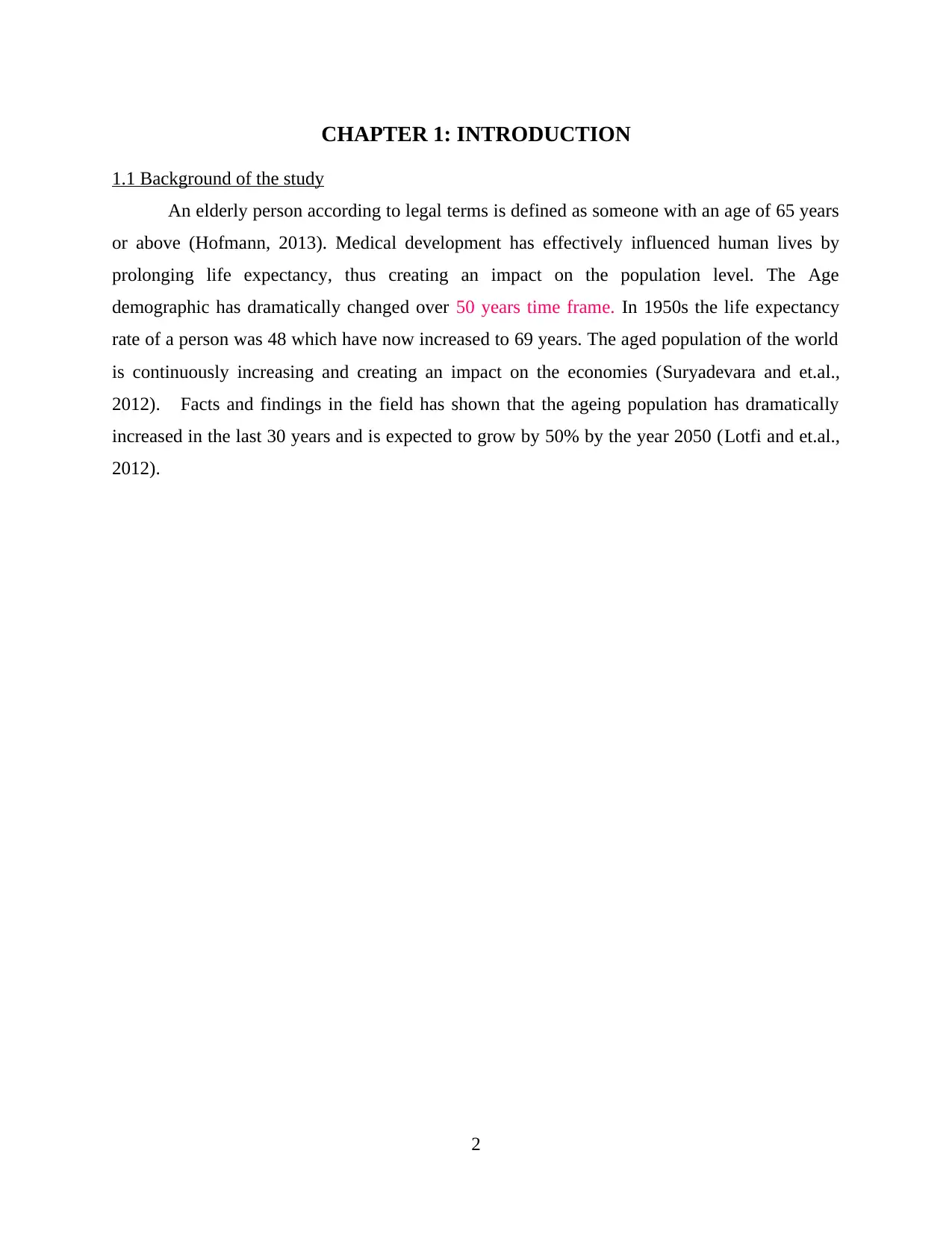
CHAPTER 1: INTRODUCTION
1.1 Background of the study
An elderly person according to legal terms is defined as someone with an age of 65 years
or above (Hofmann, 2013). Medical development has effectively influenced human lives by
prolonging life expectancy, thus creating an impact on the population level. The Age
demographic has dramatically changed over 50 years time frame. In 1950s the life expectancy
rate of a person was 48 which have now increased to 69 years. The aged population of the world
is continuously increasing and creating an impact on the economies (Suryadevara and et.al.,
2012). Facts and findings in the field has shown that the ageing population has dramatically
increased in the last 30 years and is expected to grow by 50% by the year 2050 (Lotfi and et.al.,
2012).
2
1.1 Background of the study
An elderly person according to legal terms is defined as someone with an age of 65 years
or above (Hofmann, 2013). Medical development has effectively influenced human lives by
prolonging life expectancy, thus creating an impact on the population level. The Age
demographic has dramatically changed over 50 years time frame. In 1950s the life expectancy
rate of a person was 48 which have now increased to 69 years. The aged population of the world
is continuously increasing and creating an impact on the economies (Suryadevara and et.al.,
2012). Facts and findings in the field has shown that the ageing population has dramatically
increased in the last 30 years and is expected to grow by 50% by the year 2050 (Lotfi and et.al.,
2012).
2
Paraphrase This Document
Need a fresh take? Get an instant paraphrase of this document with our AI Paraphraser
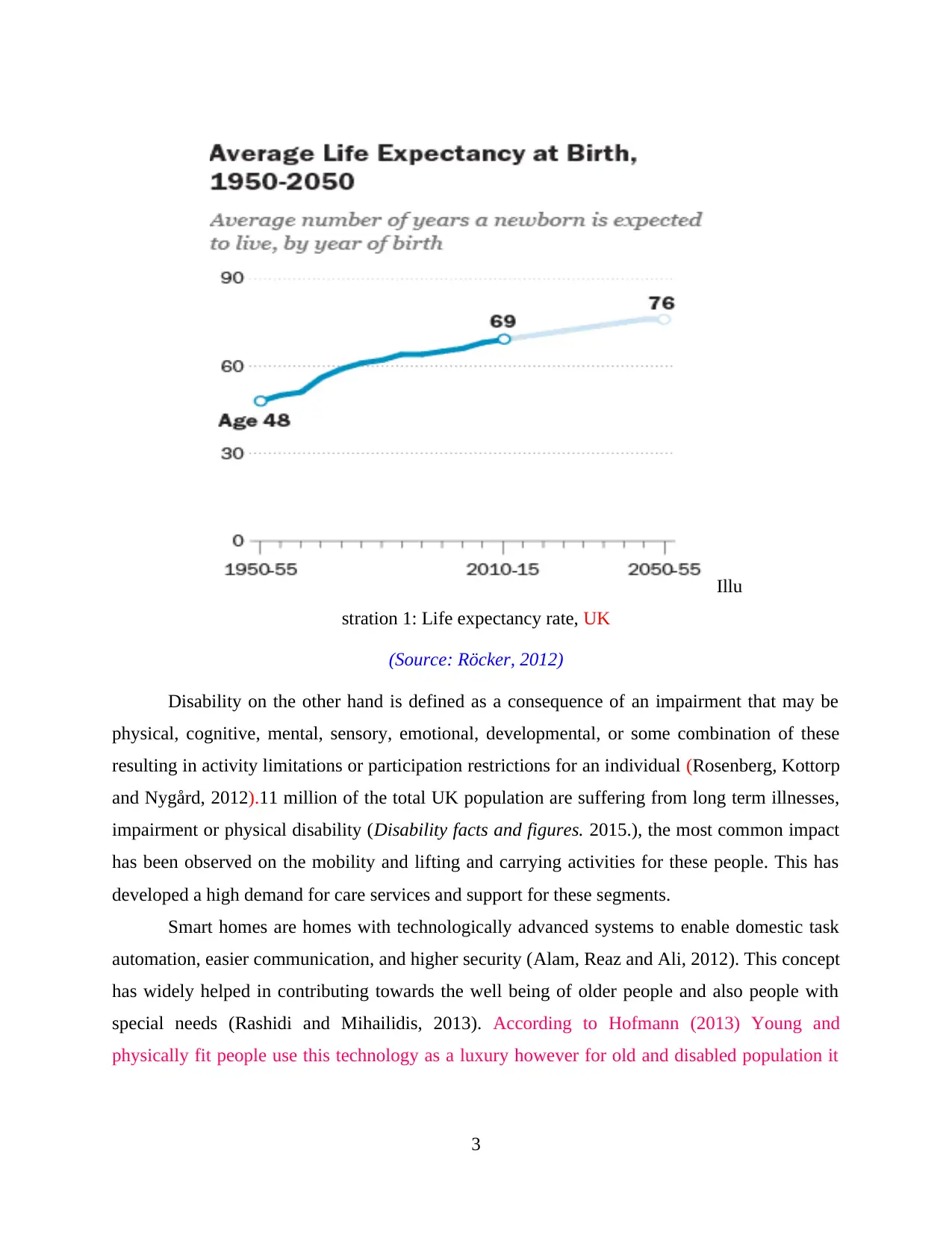
Disability on the other hand is defined as a consequence of an impairment that may be
physical, cognitive, mental, sensory, emotional, developmental, or some combination of these
resulting in activity limitations or participation restrictions for an individual (Rosenberg, Kottorp
and Nygård, 2012).11 million of the total UK population are suffering from long term illnesses,
impairment or physical disability (Disability facts and figures. 2015.), the most common impact
has been observed on the mobility and lifting and carrying activities for these people. This has
developed a high demand for care services and support for these segments.
Smart homes are homes with technologically advanced systems to enable domestic task
automation, easier communication, and higher security (Alam, Reaz and Ali, 2012). This concept
has widely helped in contributing towards the well being of older people and also people with
special needs (Rashidi and Mihailidis, 2013). According to Hofmann (2013) Young and
physically fit people use this technology as a luxury however for old and disabled population it
3
Illu
stration 1: Life expectancy rate, UK
(Source: Röcker, 2012)
physical, cognitive, mental, sensory, emotional, developmental, or some combination of these
resulting in activity limitations or participation restrictions for an individual (Rosenberg, Kottorp
and Nygård, 2012).11 million of the total UK population are suffering from long term illnesses,
impairment or physical disability (Disability facts and figures. 2015.), the most common impact
has been observed on the mobility and lifting and carrying activities for these people. This has
developed a high demand for care services and support for these segments.
Smart homes are homes with technologically advanced systems to enable domestic task
automation, easier communication, and higher security (Alam, Reaz and Ali, 2012). This concept
has widely helped in contributing towards the well being of older people and also people with
special needs (Rashidi and Mihailidis, 2013). According to Hofmann (2013) Young and
physically fit people use this technology as a luxury however for old and disabled population it
3
Illu
stration 1: Life expectancy rate, UK
(Source: Röcker, 2012)
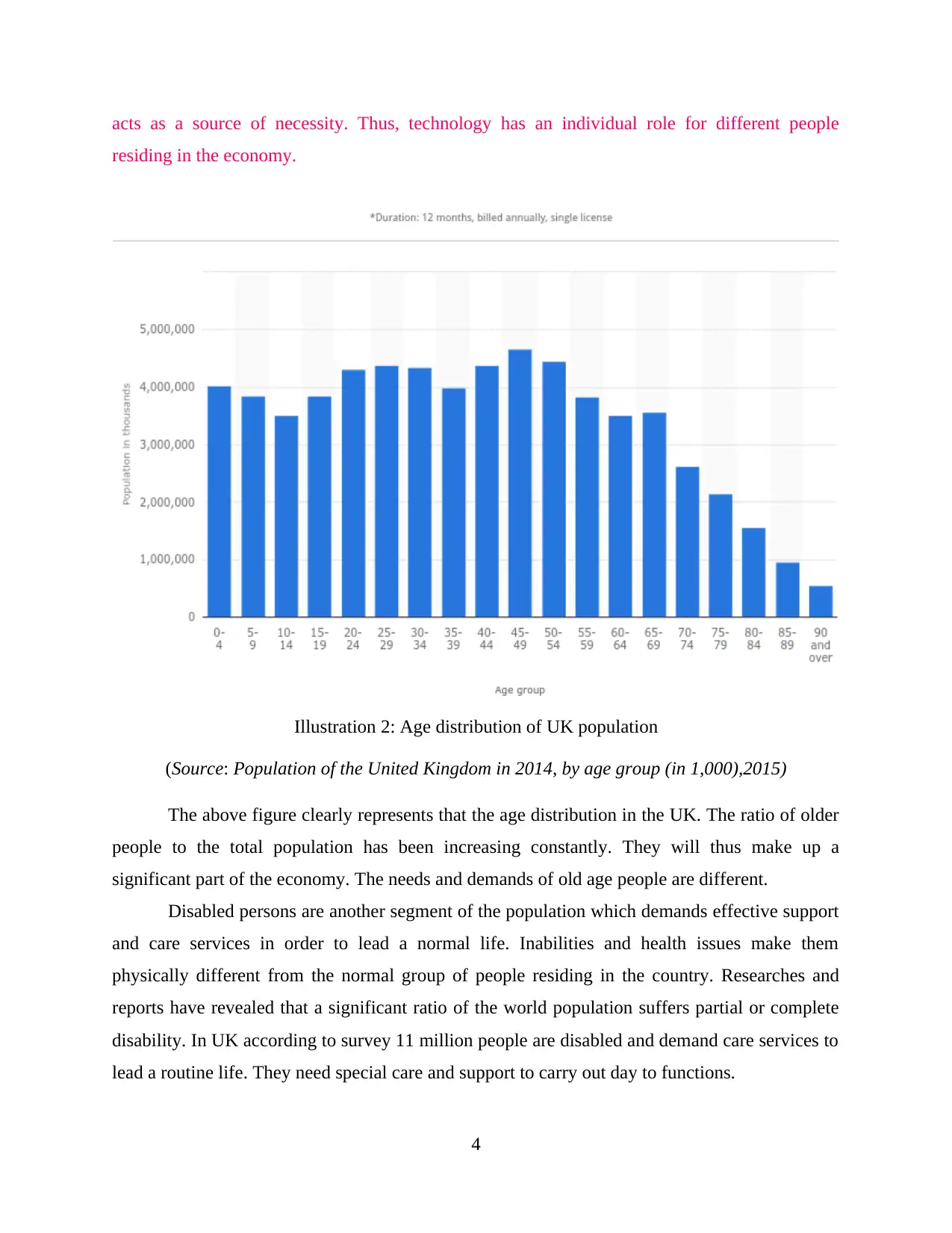
acts as a source of necessity. Thus, technology has an individual role for different people
residing in the economy.
The above figure clearly represents that the age distribution in the UK. The ratio of older
people to the total population has been increasing constantly. They will thus make up a
significant part of the economy. The needs and demands of old age people are different.
Disabled persons are another segment of the population which demands effective support
and care services in order to lead a normal life. Inabilities and health issues make them
physically different from the normal group of people residing in the country. Researches and
reports have revealed that a significant ratio of the world population suffers partial or complete
disability. In UK according to survey 11 million people are disabled and demand care services to
lead a routine life. They need special care and support to carry out day to functions.
4
Illustration 2: Age distribution of UK population
(Source: Population of the United Kingdom in 2014, by age group (in 1,000),2015)
residing in the economy.
The above figure clearly represents that the age distribution in the UK. The ratio of older
people to the total population has been increasing constantly. They will thus make up a
significant part of the economy. The needs and demands of old age people are different.
Disabled persons are another segment of the population which demands effective support
and care services in order to lead a normal life. Inabilities and health issues make them
physically different from the normal group of people residing in the country. Researches and
reports have revealed that a significant ratio of the world population suffers partial or complete
disability. In UK according to survey 11 million people are disabled and demand care services to
lead a routine life. They need special care and support to carry out day to functions.
4
Illustration 2: Age distribution of UK population
(Source: Population of the United Kingdom in 2014, by age group (in 1,000),2015)

The above figure clearly represents that large part of the UK population has different
needs and demands from rest of the population. 11.85 million People at present are above the age
of 65 years who are mostly retired or have minimum access to earning. While 11 million people,
suffer from some or other kind of disability (Refer appendix A1.) (Facts and statistics, 2015).
They demand special care services to carry out their routine lives because due to their special
needs they are dependent on other to live a usual life (Chen, Nugent and Wang, 2012). It
increases dependency and thus demands proper and regular care for a person. Developing
technologies and change lifestyles of people has created a direct impact on issues related to
support and independent living for elder and disabled people. Health issue and increasing level
of dependency will demand the need of higher care services such as residential care, medical
care, independent living etc. Adopting technologies for care taking services will help in
supporting the segment definitely for elder or disabled people (Analysis of UK long term care
market, 2016).
The framework of smart homes focuses on providing the five basic features to service
users which include automation, multi functionality, adaptability, interactivity and efficiency
(Baig and Gholamhosseini, 2013). Advanced technologies such as alarms, sensitive detector,
automatic lightings, smart and easily accessible media etc. are the key support of these care
5
Illustration 3: Elderly and Disabled population of UK (2015)
(Source: Self attempted)
needs and demands from rest of the population. 11.85 million People at present are above the age
of 65 years who are mostly retired or have minimum access to earning. While 11 million people,
suffer from some or other kind of disability (Refer appendix A1.) (Facts and statistics, 2015).
They demand special care services to carry out their routine lives because due to their special
needs they are dependent on other to live a usual life (Chen, Nugent and Wang, 2012). It
increases dependency and thus demands proper and regular care for a person. Developing
technologies and change lifestyles of people has created a direct impact on issues related to
support and independent living for elder and disabled people. Health issue and increasing level
of dependency will demand the need of higher care services such as residential care, medical
care, independent living etc. Adopting technologies for care taking services will help in
supporting the segment definitely for elder or disabled people (Analysis of UK long term care
market, 2016).
The framework of smart homes focuses on providing the five basic features to service
users which include automation, multi functionality, adaptability, interactivity and efficiency
(Baig and Gholamhosseini, 2013). Advanced technologies such as alarms, sensitive detector,
automatic lightings, smart and easily accessible media etc. are the key support of these care
5
Illustration 3: Elderly and Disabled population of UK (2015)
(Source: Self attempted)
Secure Best Marks with AI Grader
Need help grading? Try our AI Grader for instant feedback on your assignments.
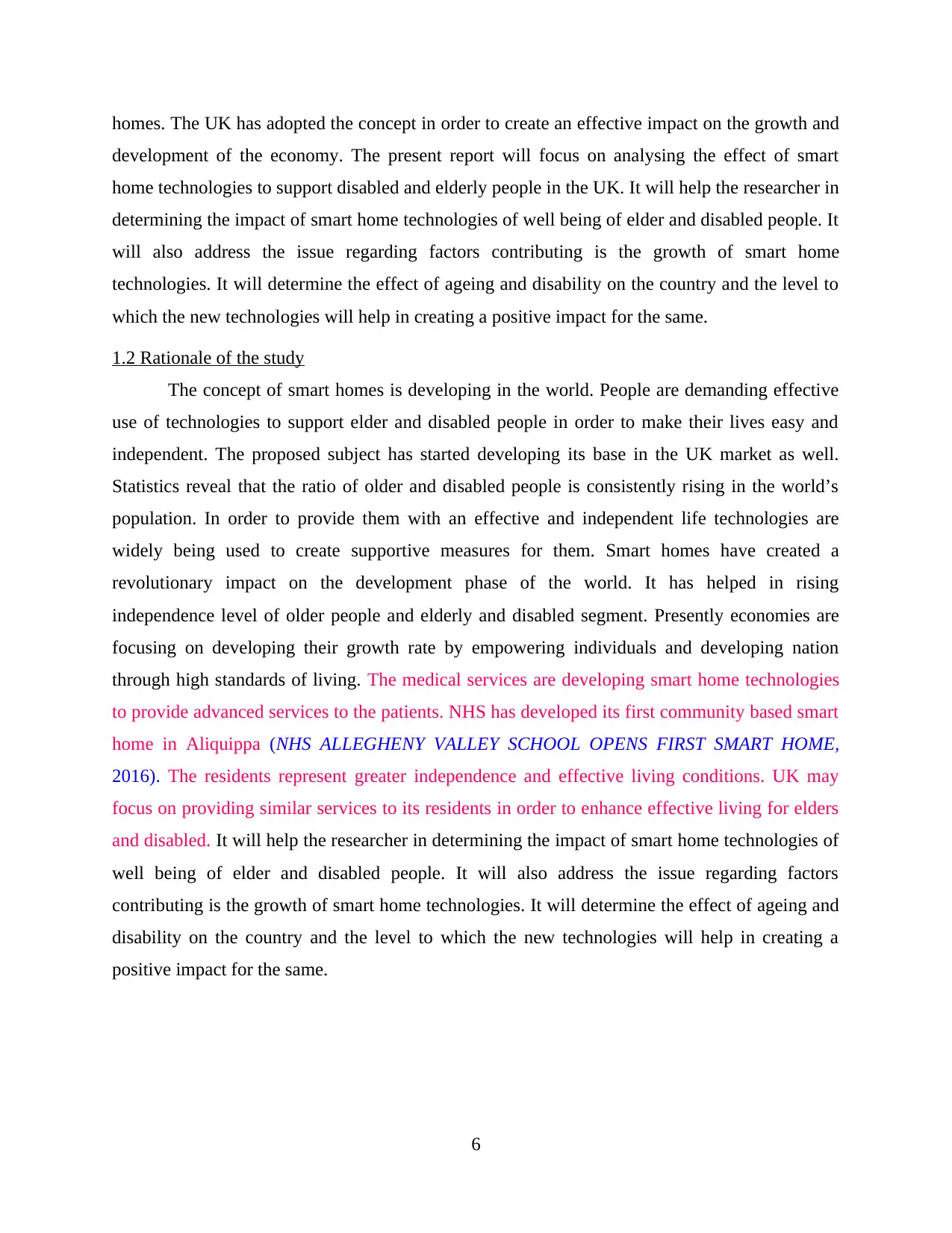
homes. The UK has adopted the concept in order to create an effective impact on the growth and
development of the economy. The present report will focus on analysing the effect of smart
home technologies to support disabled and elderly people in the UK. It will help the researcher in
determining the impact of smart home technologies of well being of elder and disabled people. It
will also address the issue regarding factors contributing is the growth of smart home
technologies. It will determine the effect of ageing and disability on the country and the level to
which the new technologies will help in creating a positive impact for the same.
1.2 Rationale of the study
The concept of smart homes is developing in the world. People are demanding effective
use of technologies to support elder and disabled people in order to make their lives easy and
independent. The proposed subject has started developing its base in the UK market as well.
Statistics reveal that the ratio of older and disabled people is consistently rising in the world’s
population. In order to provide them with an effective and independent life technologies are
widely being used to create supportive measures for them. Smart homes have created a
revolutionary impact on the development phase of the world. It has helped in rising
independence level of older people and elderly and disabled segment. Presently economies are
focusing on developing their growth rate by empowering individuals and developing nation
through high standards of living. The medical services are developing smart home technologies
to provide advanced services to the patients. NHS has developed its first community based smart
home in Aliquippa (NHS ALLEGHENY VALLEY SCHOOL OPENS FIRST SMART HOME,
2016). The residents represent greater independence and effective living conditions. UK may
focus on providing similar services to its residents in order to enhance effective living for elders
and disabled. It will help the researcher in determining the impact of smart home technologies of
well being of elder and disabled people. It will also address the issue regarding factors
contributing is the growth of smart home technologies. It will determine the effect of ageing and
disability on the country and the level to which the new technologies will help in creating a
positive impact for the same.
6
development of the economy. The present report will focus on analysing the effect of smart
home technologies to support disabled and elderly people in the UK. It will help the researcher in
determining the impact of smart home technologies of well being of elder and disabled people. It
will also address the issue regarding factors contributing is the growth of smart home
technologies. It will determine the effect of ageing and disability on the country and the level to
which the new technologies will help in creating a positive impact for the same.
1.2 Rationale of the study
The concept of smart homes is developing in the world. People are demanding effective
use of technologies to support elder and disabled people in order to make their lives easy and
independent. The proposed subject has started developing its base in the UK market as well.
Statistics reveal that the ratio of older and disabled people is consistently rising in the world’s
population. In order to provide them with an effective and independent life technologies are
widely being used to create supportive measures for them. Smart homes have created a
revolutionary impact on the development phase of the world. It has helped in rising
independence level of older people and elderly and disabled segment. Presently economies are
focusing on developing their growth rate by empowering individuals and developing nation
through high standards of living. The medical services are developing smart home technologies
to provide advanced services to the patients. NHS has developed its first community based smart
home in Aliquippa (NHS ALLEGHENY VALLEY SCHOOL OPENS FIRST SMART HOME,
2016). The residents represent greater independence and effective living conditions. UK may
focus on providing similar services to its residents in order to enhance effective living for elders
and disabled. It will help the researcher in determining the impact of smart home technologies of
well being of elder and disabled people. It will also address the issue regarding factors
contributing is the growth of smart home technologies. It will determine the effect of ageing and
disability on the country and the level to which the new technologies will help in creating a
positive impact for the same.
6
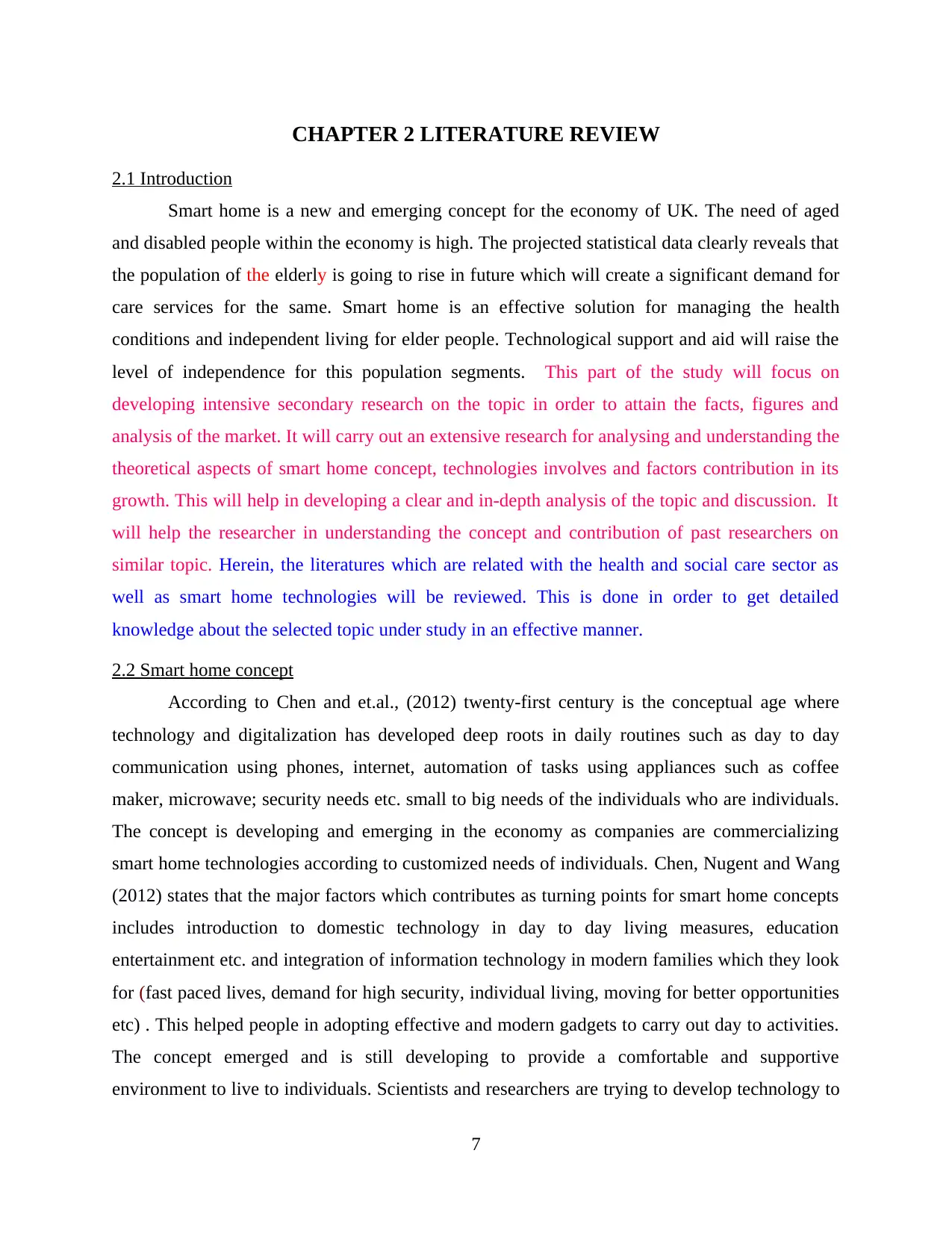
CHAPTER 2 LITERATURE REVIEW
2.1 Introduction
Smart home is a new and emerging concept for the economy of UK. The need of aged
and disabled people within the economy is high. The projected statistical data clearly reveals that
the population of the elderly is going to rise in future which will create a significant demand for
care services for the same. Smart home is an effective solution for managing the health
conditions and independent living for elder people. Technological support and aid will raise the
level of independence for this population segments. This part of the study will focus on
developing intensive secondary research on the topic in order to attain the facts, figures and
analysis of the market. It will carry out an extensive research for analysing and understanding the
theoretical aspects of smart home concept, technologies involves and factors contribution in its
growth. This will help in developing a clear and in-depth analysis of the topic and discussion. It
will help the researcher in understanding the concept and contribution of past researchers on
similar topic. Herein, the literatures which are related with the health and social care sector as
well as smart home technologies will be reviewed. This is done in order to get detailed
knowledge about the selected topic under study in an effective manner.
2.2 Smart home concept
According to Chen and et.al., (2012) twenty-first century is the conceptual age where
technology and digitalization has developed deep roots in daily routines such as day to day
communication using phones, internet, automation of tasks using appliances such as coffee
maker, microwave; security needs etc. small to big needs of the individuals who are individuals.
The concept is developing and emerging in the economy as companies are commercializing
smart home technologies according to customized needs of individuals. Chen, Nugent and Wang
(2012) states that the major factors which contributes as turning points for smart home concepts
includes introduction to domestic technology in day to day living measures, education
entertainment etc. and integration of information technology in modern families which they look
for (fast paced lives, demand for high security, individual living, moving for better opportunities
etc) . This helped people in adopting effective and modern gadgets to carry out day to activities.
The concept emerged and is still developing to provide a comfortable and supportive
environment to live to individuals. Scientists and researchers are trying to develop technology to
7
2.1 Introduction
Smart home is a new and emerging concept for the economy of UK. The need of aged
and disabled people within the economy is high. The projected statistical data clearly reveals that
the population of the elderly is going to rise in future which will create a significant demand for
care services for the same. Smart home is an effective solution for managing the health
conditions and independent living for elder people. Technological support and aid will raise the
level of independence for this population segments. This part of the study will focus on
developing intensive secondary research on the topic in order to attain the facts, figures and
analysis of the market. It will carry out an extensive research for analysing and understanding the
theoretical aspects of smart home concept, technologies involves and factors contribution in its
growth. This will help in developing a clear and in-depth analysis of the topic and discussion. It
will help the researcher in understanding the concept and contribution of past researchers on
similar topic. Herein, the literatures which are related with the health and social care sector as
well as smart home technologies will be reviewed. This is done in order to get detailed
knowledge about the selected topic under study in an effective manner.
2.2 Smart home concept
According to Chen and et.al., (2012) twenty-first century is the conceptual age where
technology and digitalization has developed deep roots in daily routines such as day to day
communication using phones, internet, automation of tasks using appliances such as coffee
maker, microwave; security needs etc. small to big needs of the individuals who are individuals.
The concept is developing and emerging in the economy as companies are commercializing
smart home technologies according to customized needs of individuals. Chen, Nugent and Wang
(2012) states that the major factors which contributes as turning points for smart home concepts
includes introduction to domestic technology in day to day living measures, education
entertainment etc. and integration of information technology in modern families which they look
for (fast paced lives, demand for high security, individual living, moving for better opportunities
etc) . This helped people in adopting effective and modern gadgets to carry out day to activities.
The concept emerged and is still developing to provide a comfortable and supportive
environment to live to individuals. Scientists and researchers are trying to develop technology to
7
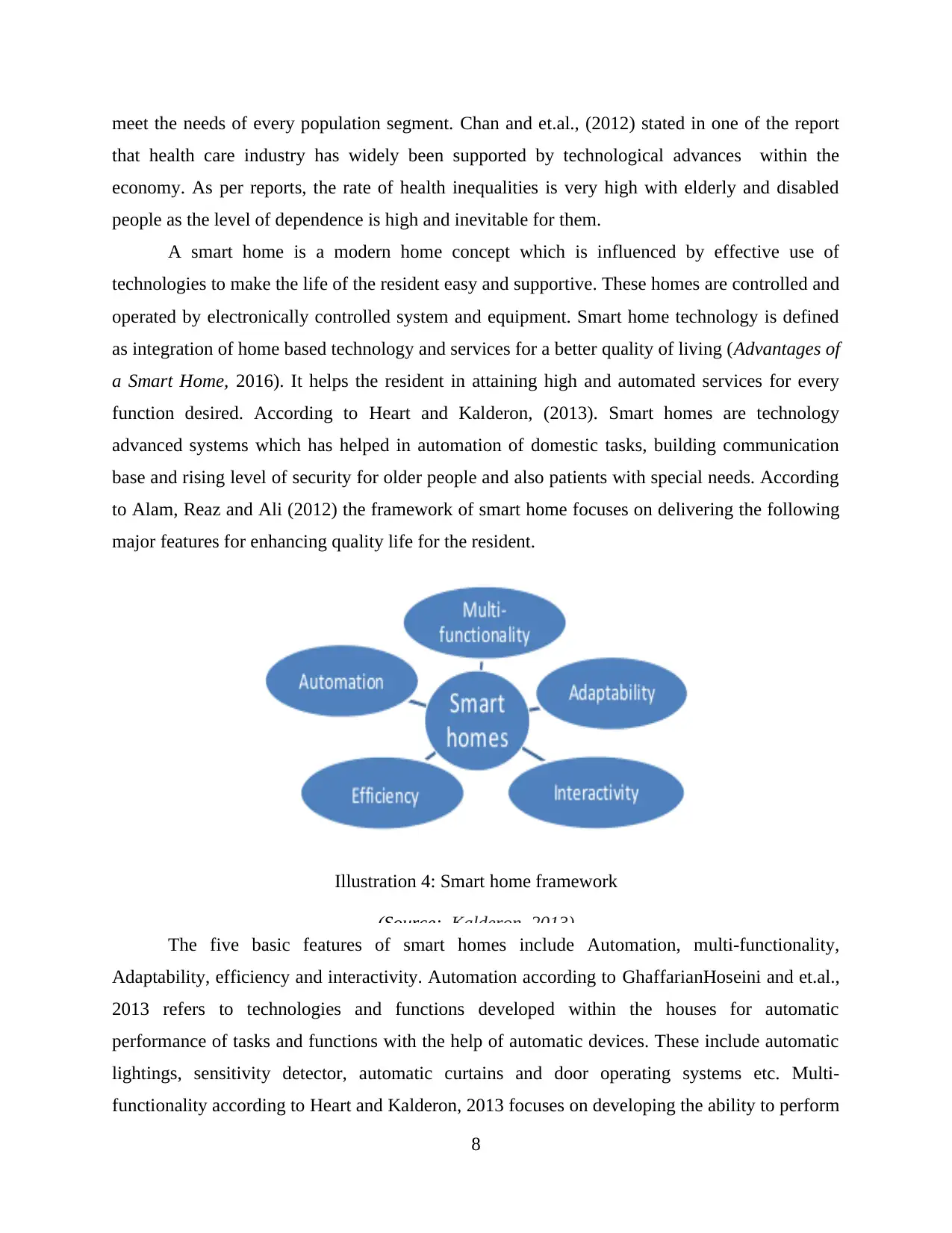
meet the needs of every population segment. Chan and et.al., (2012) stated in one of the report
that health care industry has widely been supported by technological advances within the
economy. As per reports, the rate of health inequalities is very high with elderly and disabled
people as the level of dependence is high and inevitable for them.
A smart home is a modern home concept which is influenced by effective use of
technologies to make the life of the resident easy and supportive. These homes are controlled and
operated by electronically controlled system and equipment. Smart home technology is defined
as integration of home based technology and services for a better quality of living (Advantages of
a Smart Home, 2016). It helps the resident in attaining high and automated services for every
function desired. According to Heart and Kalderon, (2013). Smart homes are technology
advanced systems which has helped in automation of domestic tasks, building communication
base and rising level of security for older people and also patients with special needs. According
to Alam, Reaz and Ali (2012) the framework of smart home focuses on delivering the following
major features for enhancing quality life for the resident.
The five basic features of smart homes include Automation, multi-functionality,
Adaptability, efficiency and interactivity. Automation according to GhaffarianHoseini and et.al.,
2013 refers to technologies and functions developed within the houses for automatic
performance of tasks and functions with the help of automatic devices. These include automatic
lightings, sensitivity detector, automatic curtains and door operating systems etc. Multi-
functionality according to Heart and Kalderon, 2013 focuses on developing the ability to perform
8
Illustration 4: Smart home framework
(Source: Kalderon, 2013)
that health care industry has widely been supported by technological advances within the
economy. As per reports, the rate of health inequalities is very high with elderly and disabled
people as the level of dependence is high and inevitable for them.
A smart home is a modern home concept which is influenced by effective use of
technologies to make the life of the resident easy and supportive. These homes are controlled and
operated by electronically controlled system and equipment. Smart home technology is defined
as integration of home based technology and services for a better quality of living (Advantages of
a Smart Home, 2016). It helps the resident in attaining high and automated services for every
function desired. According to Heart and Kalderon, (2013). Smart homes are technology
advanced systems which has helped in automation of domestic tasks, building communication
base and rising level of security for older people and also patients with special needs. According
to Alam, Reaz and Ali (2012) the framework of smart home focuses on delivering the following
major features for enhancing quality life for the resident.
The five basic features of smart homes include Automation, multi-functionality,
Adaptability, efficiency and interactivity. Automation according to GhaffarianHoseini and et.al.,
2013 refers to technologies and functions developed within the houses for automatic
performance of tasks and functions with the help of automatic devices. These include automatic
lightings, sensitivity detector, automatic curtains and door operating systems etc. Multi-
functionality according to Heart and Kalderon, 2013 focuses on developing the ability to perform
8
Illustration 4: Smart home framework
(Source: Kalderon, 2013)
Paraphrase This Document
Need a fresh take? Get an instant paraphrase of this document with our AI Paraphraser
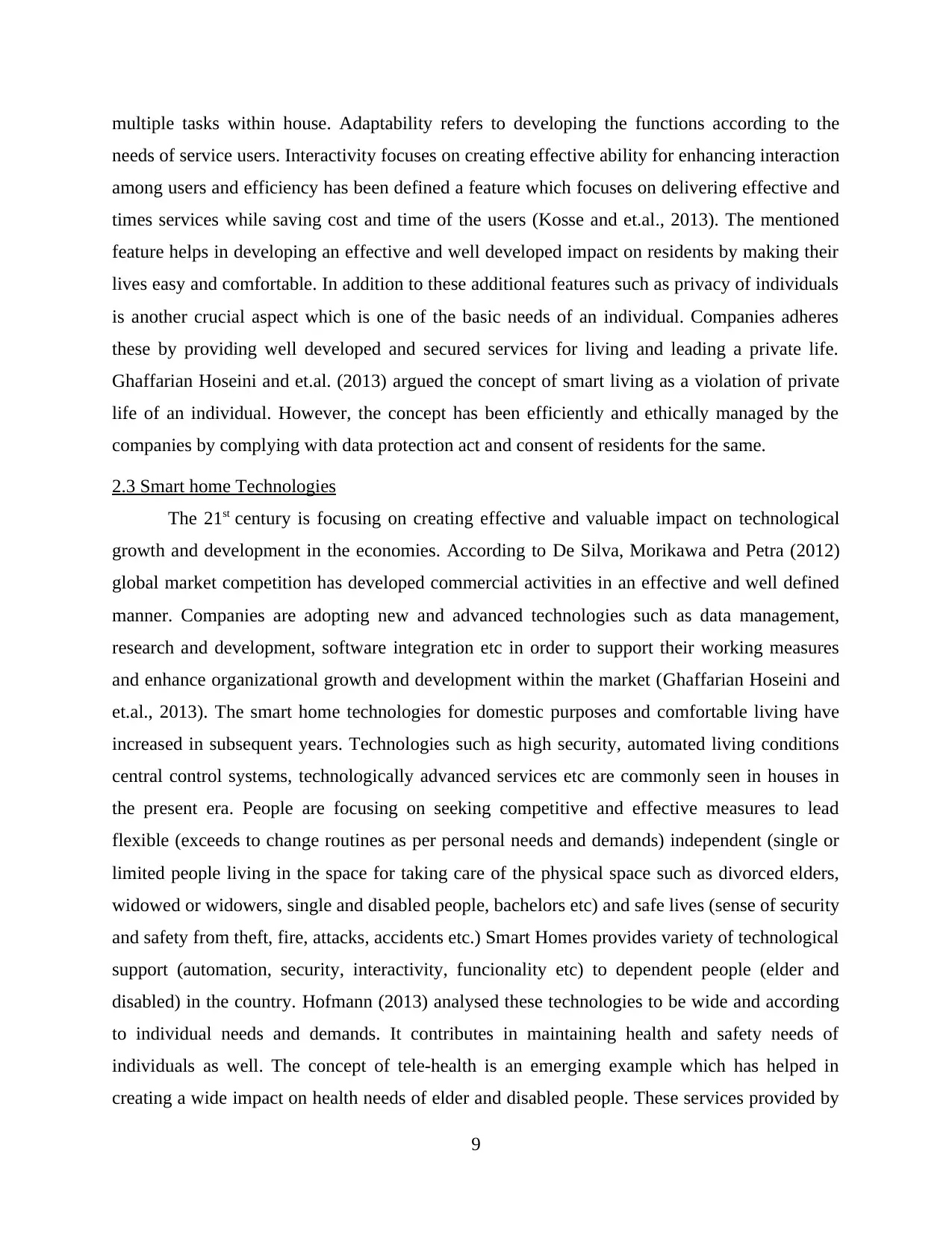
multiple tasks within house. Adaptability refers to developing the functions according to the
needs of service users. Interactivity focuses on creating effective ability for enhancing interaction
among users and efficiency has been defined a feature which focuses on delivering effective and
times services while saving cost and time of the users (Kosse and et.al., 2013). The mentioned
feature helps in developing an effective and well developed impact on residents by making their
lives easy and comfortable. In addition to these additional features such as privacy of individuals
is another crucial aspect which is one of the basic needs of an individual. Companies adheres
these by providing well developed and secured services for living and leading a private life.
Ghaffarian Hoseini and et.al. (2013) argued the concept of smart living as a violation of private
life of an individual. However, the concept has been efficiently and ethically managed by the
companies by complying with data protection act and consent of residents for the same.
2.3 Smart home Technologies
The 21st century is focusing on creating effective and valuable impact on technological
growth and development in the economies. According to De Silva, Morikawa and Petra (2012)
global market competition has developed commercial activities in an effective and well defined
manner. Companies are adopting new and advanced technologies such as data management,
research and development, software integration etc in order to support their working measures
and enhance organizational growth and development within the market (Ghaffarian Hoseini and
et.al., 2013). The smart home technologies for domestic purposes and comfortable living have
increased in subsequent years. Technologies such as high security, automated living conditions
central control systems, technologically advanced services etc are commonly seen in houses in
the present era. People are focusing on seeking competitive and effective measures to lead
flexible (exceeds to change routines as per personal needs and demands) independent (single or
limited people living in the space for taking care of the physical space such as divorced elders,
widowed or widowers, single and disabled people, bachelors etc) and safe lives (sense of security
and safety from theft, fire, attacks, accidents etc.) Smart Homes provides variety of technological
support (automation, security, interactivity, funcionality etc) to dependent people (elder and
disabled) in the country. Hofmann (2013) analysed these technologies to be wide and according
to individual needs and demands. It contributes in maintaining health and safety needs of
individuals as well. The concept of tele-health is an emerging example which has helped in
creating a wide impact on health needs of elder and disabled people. These services provided by
9
needs of service users. Interactivity focuses on creating effective ability for enhancing interaction
among users and efficiency has been defined a feature which focuses on delivering effective and
times services while saving cost and time of the users (Kosse and et.al., 2013). The mentioned
feature helps in developing an effective and well developed impact on residents by making their
lives easy and comfortable. In addition to these additional features such as privacy of individuals
is another crucial aspect which is one of the basic needs of an individual. Companies adheres
these by providing well developed and secured services for living and leading a private life.
Ghaffarian Hoseini and et.al. (2013) argued the concept of smart living as a violation of private
life of an individual. However, the concept has been efficiently and ethically managed by the
companies by complying with data protection act and consent of residents for the same.
2.3 Smart home Technologies
The 21st century is focusing on creating effective and valuable impact on technological
growth and development in the economies. According to De Silva, Morikawa and Petra (2012)
global market competition has developed commercial activities in an effective and well defined
manner. Companies are adopting new and advanced technologies such as data management,
research and development, software integration etc in order to support their working measures
and enhance organizational growth and development within the market (Ghaffarian Hoseini and
et.al., 2013). The smart home technologies for domestic purposes and comfortable living have
increased in subsequent years. Technologies such as high security, automated living conditions
central control systems, technologically advanced services etc are commonly seen in houses in
the present era. People are focusing on seeking competitive and effective measures to lead
flexible (exceeds to change routines as per personal needs and demands) independent (single or
limited people living in the space for taking care of the physical space such as divorced elders,
widowed or widowers, single and disabled people, bachelors etc) and safe lives (sense of security
and safety from theft, fire, attacks, accidents etc.) Smart Homes provides variety of technological
support (automation, security, interactivity, funcionality etc) to dependent people (elder and
disabled) in the country. Hofmann (2013) analysed these technologies to be wide and according
to individual needs and demands. It contributes in maintaining health and safety needs of
individuals as well. The concept of tele-health is an emerging example which has helped in
creating a wide impact on health needs of elder and disabled people. These services provided by
9

the companies have focused on attaining basic health enquires and precaution through tele
communication and conferencing. This has helped in minimizing demand for medical care
facilities.
To understand the potential of smart homes the knowledge and significance the standards
used for the technologies is important. Domingo (2012) defined the general components of smart
technology which includes sensors, actuators, controllers, central unit, networks and interface.
Sensors are the elements installed which helps in measuring the surrounding activities of
a place. These are variety of sensors used within a living area which helps in identifying the limit
10
Illustration 5: Components of technology
(Source:Best Smart Home Gadgets of 2016, 2016)
communication and conferencing. This has helped in minimizing demand for medical care
facilities.
To understand the potential of smart homes the knowledge and significance the standards
used for the technologies is important. Domingo (2012) defined the general components of smart
technology which includes sensors, actuators, controllers, central unit, networks and interface.
Sensors are the elements installed which helps in measuring the surrounding activities of
a place. These are variety of sensors used within a living area which helps in identifying the limit
10
Illustration 5: Components of technology
(Source:Best Smart Home Gadgets of 2016, 2016)
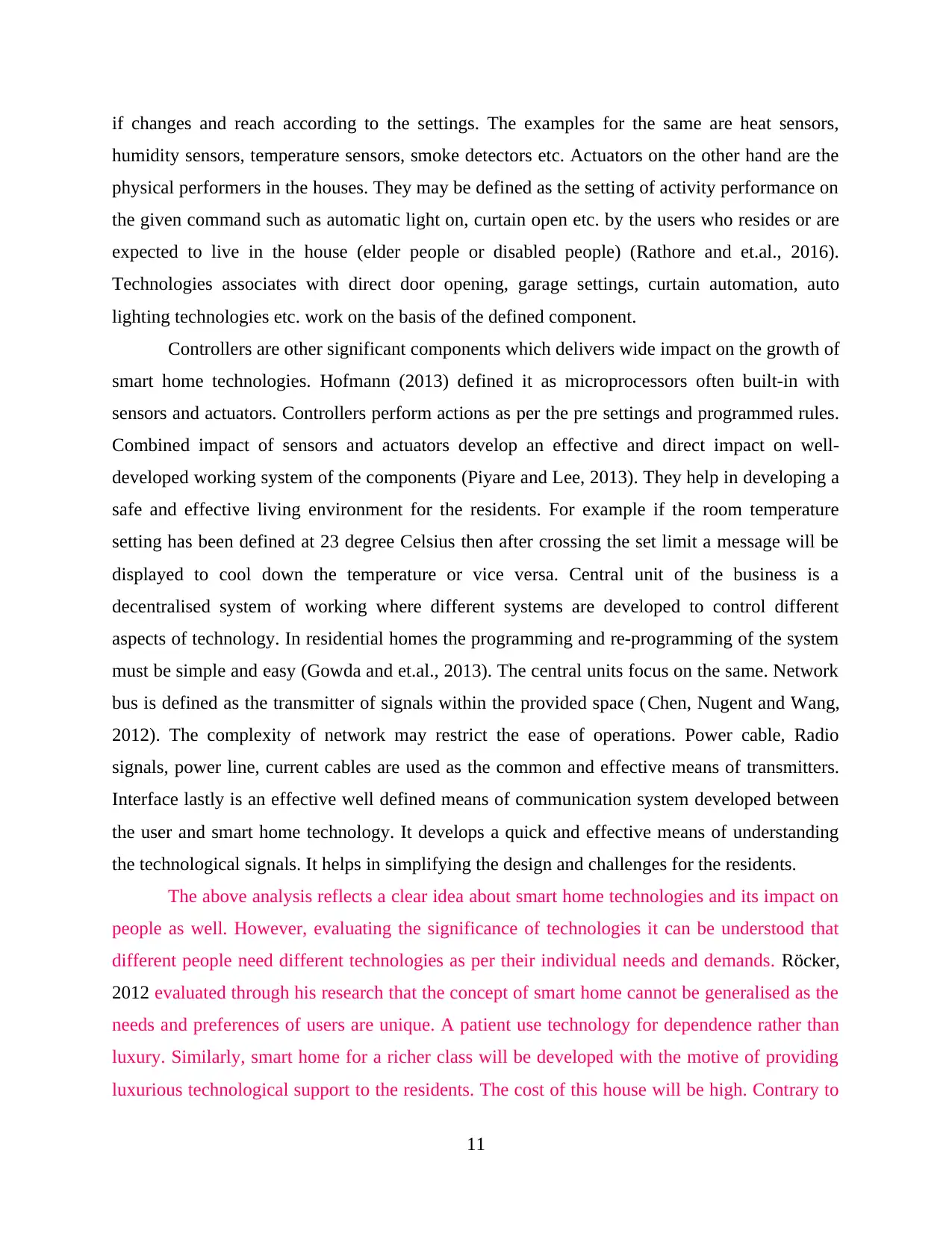
if changes and reach according to the settings. The examples for the same are heat sensors,
humidity sensors, temperature sensors, smoke detectors etc. Actuators on the other hand are the
physical performers in the houses. They may be defined as the setting of activity performance on
the given command such as automatic light on, curtain open etc. by the users who resides or are
expected to live in the house (elder people or disabled people) (Rathore and et.al., 2016).
Technologies associates with direct door opening, garage settings, curtain automation, auto
lighting technologies etc. work on the basis of the defined component.
Controllers are other significant components which delivers wide impact on the growth of
smart home technologies. Hofmann (2013) defined it as microprocessors often built-in with
sensors and actuators. Controllers perform actions as per the pre settings and programmed rules.
Combined impact of sensors and actuators develop an effective and direct impact on well-
developed working system of the components (Piyare and Lee, 2013). They help in developing a
safe and effective living environment for the residents. For example if the room temperature
setting has been defined at 23 degree Celsius then after crossing the set limit a message will be
displayed to cool down the temperature or vice versa. Central unit of the business is a
decentralised system of working where different systems are developed to control different
aspects of technology. In residential homes the programming and re-programming of the system
must be simple and easy (Gowda and et.al., 2013). The central units focus on the same. Network
bus is defined as the transmitter of signals within the provided space (Chen, Nugent and Wang,
2012). The complexity of network may restrict the ease of operations. Power cable, Radio
signals, power line, current cables are used as the common and effective means of transmitters.
Interface lastly is an effective well defined means of communication system developed between
the user and smart home technology. It develops a quick and effective means of understanding
the technological signals. It helps in simplifying the design and challenges for the residents.
The above analysis reflects a clear idea about smart home technologies and its impact on
people as well. However, evaluating the significance of technologies it can be understood that
different people need different technologies as per their individual needs and demands. Röcker,
2012 evaluated through his research that the concept of smart home cannot be generalised as the
needs and preferences of users are unique. A patient use technology for dependence rather than
luxury. Similarly, smart home for a richer class will be developed with the motive of providing
luxurious technological support to the residents. The cost of this house will be high. Contrary to
11
humidity sensors, temperature sensors, smoke detectors etc. Actuators on the other hand are the
physical performers in the houses. They may be defined as the setting of activity performance on
the given command such as automatic light on, curtain open etc. by the users who resides or are
expected to live in the house (elder people or disabled people) (Rathore and et.al., 2016).
Technologies associates with direct door opening, garage settings, curtain automation, auto
lighting technologies etc. work on the basis of the defined component.
Controllers are other significant components which delivers wide impact on the growth of
smart home technologies. Hofmann (2013) defined it as microprocessors often built-in with
sensors and actuators. Controllers perform actions as per the pre settings and programmed rules.
Combined impact of sensors and actuators develop an effective and direct impact on well-
developed working system of the components (Piyare and Lee, 2013). They help in developing a
safe and effective living environment for the residents. For example if the room temperature
setting has been defined at 23 degree Celsius then after crossing the set limit a message will be
displayed to cool down the temperature or vice versa. Central unit of the business is a
decentralised system of working where different systems are developed to control different
aspects of technology. In residential homes the programming and re-programming of the system
must be simple and easy (Gowda and et.al., 2013). The central units focus on the same. Network
bus is defined as the transmitter of signals within the provided space (Chen, Nugent and Wang,
2012). The complexity of network may restrict the ease of operations. Power cable, Radio
signals, power line, current cables are used as the common and effective means of transmitters.
Interface lastly is an effective well defined means of communication system developed between
the user and smart home technology. It develops a quick and effective means of understanding
the technological signals. It helps in simplifying the design and challenges for the residents.
The above analysis reflects a clear idea about smart home technologies and its impact on
people as well. However, evaluating the significance of technologies it can be understood that
different people need different technologies as per their individual needs and demands. Röcker,
2012 evaluated through his research that the concept of smart home cannot be generalised as the
needs and preferences of users are unique. A patient use technology for dependence rather than
luxury. Similarly, smart home for a richer class will be developed with the motive of providing
luxurious technological support to the residents. The cost of this house will be high. Contrary to
11
Secure Best Marks with AI Grader
Need help grading? Try our AI Grader for instant feedback on your assignments.

this smart home concept for elder and disabled is different as this demands specified and
technologies as per the disabilities or specified demands of the people. For example, there are
many town complexes are also designing in China. These complexes are smart and helps in
fulfilling all the essential needs and demands of its customers.
2.4 Advantages associated with smart home concepts
Smart homes consists of features which help in making lives easy through easy access to
information, communication and automation along with comfortable as movement is minimized
and work is done on single click or movement (such as automatic lighting, tele health) for elder
and disabled people. According to Heart and Kalderon (2013) smart technologies are defined as
devices that uses electricity can be put on a home network and at an individual's command.
These are common and effective measures of resolving individual issues within a community.
12
Illustration 6: Smart home technologies
technologies as per the disabilities or specified demands of the people. For example, there are
many town complexes are also designing in China. These complexes are smart and helps in
fulfilling all the essential needs and demands of its customers.
2.4 Advantages associated with smart home concepts
Smart homes consists of features which help in making lives easy through easy access to
information, communication and automation along with comfortable as movement is minimized
and work is done on single click or movement (such as automatic lighting, tele health) for elder
and disabled people. According to Heart and Kalderon (2013) smart technologies are defined as
devices that uses electricity can be put on a home network and at an individual's command.
These are common and effective measures of resolving individual issues within a community.
12
Illustration 6: Smart home technologies
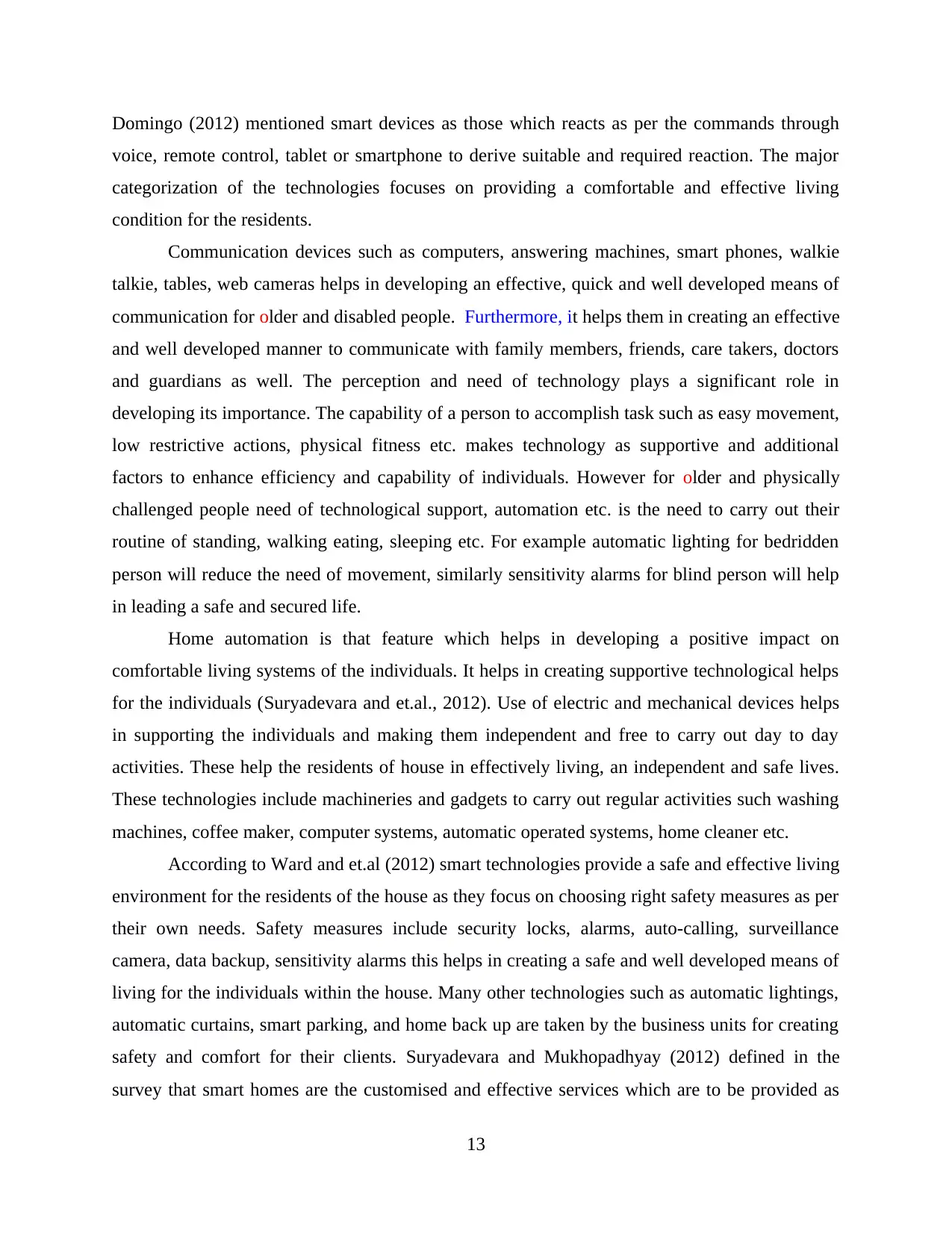
Domingo (2012) mentioned smart devices as those which reacts as per the commands through
voice, remote control, tablet or smartphone to derive suitable and required reaction. The major
categorization of the technologies focuses on providing a comfortable and effective living
condition for the residents.
Communication devices such as computers, answering machines, smart phones, walkie
talkie, tables, web cameras helps in developing an effective, quick and well developed means of
communication for older and disabled people. Furthermore, it helps them in creating an effective
and well developed manner to communicate with family members, friends, care takers, doctors
and guardians as well. The perception and need of technology plays a significant role in
developing its importance. The capability of a person to accomplish task such as easy movement,
low restrictive actions, physical fitness etc. makes technology as supportive and additional
factors to enhance efficiency and capability of individuals. However for older and physically
challenged people need of technological support, automation etc. is the need to carry out their
routine of standing, walking eating, sleeping etc. For example automatic lighting for bedridden
person will reduce the need of movement, similarly sensitivity alarms for blind person will help
in leading a safe and secured life.
Home automation is that feature which helps in developing a positive impact on
comfortable living systems of the individuals. It helps in creating supportive technological helps
for the individuals (Suryadevara and et.al., 2012). Use of electric and mechanical devices helps
in supporting the individuals and making them independent and free to carry out day to day
activities. These help the residents of house in effectively living, an independent and safe lives.
These technologies include machineries and gadgets to carry out regular activities such washing
machines, coffee maker, computer systems, automatic operated systems, home cleaner etc.
According to Ward and et.al (2012) smart technologies provide a safe and effective living
environment for the residents of the house as they focus on choosing right safety measures as per
their own needs. Safety measures include security locks, alarms, auto-calling, surveillance
camera, data backup, sensitivity alarms this helps in creating a safe and well developed means of
living for the individuals within the house. Many other technologies such as automatic lightings,
automatic curtains, smart parking, and home back up are taken by the business units for creating
safety and comfort for their clients. Suryadevara and Mukhopadhyay (2012) defined in the
survey that smart homes are the customised and effective services which are to be provided as
13
voice, remote control, tablet or smartphone to derive suitable and required reaction. The major
categorization of the technologies focuses on providing a comfortable and effective living
condition for the residents.
Communication devices such as computers, answering machines, smart phones, walkie
talkie, tables, web cameras helps in developing an effective, quick and well developed means of
communication for older and disabled people. Furthermore, it helps them in creating an effective
and well developed manner to communicate with family members, friends, care takers, doctors
and guardians as well. The perception and need of technology plays a significant role in
developing its importance. The capability of a person to accomplish task such as easy movement,
low restrictive actions, physical fitness etc. makes technology as supportive and additional
factors to enhance efficiency and capability of individuals. However for older and physically
challenged people need of technological support, automation etc. is the need to carry out their
routine of standing, walking eating, sleeping etc. For example automatic lighting for bedridden
person will reduce the need of movement, similarly sensitivity alarms for blind person will help
in leading a safe and secured life.
Home automation is that feature which helps in developing a positive impact on
comfortable living systems of the individuals. It helps in creating supportive technological helps
for the individuals (Suryadevara and et.al., 2012). Use of electric and mechanical devices helps
in supporting the individuals and making them independent and free to carry out day to day
activities. These help the residents of house in effectively living, an independent and safe lives.
These technologies include machineries and gadgets to carry out regular activities such washing
machines, coffee maker, computer systems, automatic operated systems, home cleaner etc.
According to Ward and et.al (2012) smart technologies provide a safe and effective living
environment for the residents of the house as they focus on choosing right safety measures as per
their own needs. Safety measures include security locks, alarms, auto-calling, surveillance
camera, data backup, sensitivity alarms this helps in creating a safe and well developed means of
living for the individuals within the house. Many other technologies such as automatic lightings,
automatic curtains, smart parking, and home back up are taken by the business units for creating
safety and comfort for their clients. Suryadevara and Mukhopadhyay (2012) defined in the
survey that smart homes are the customised and effective services which are to be provided as
13
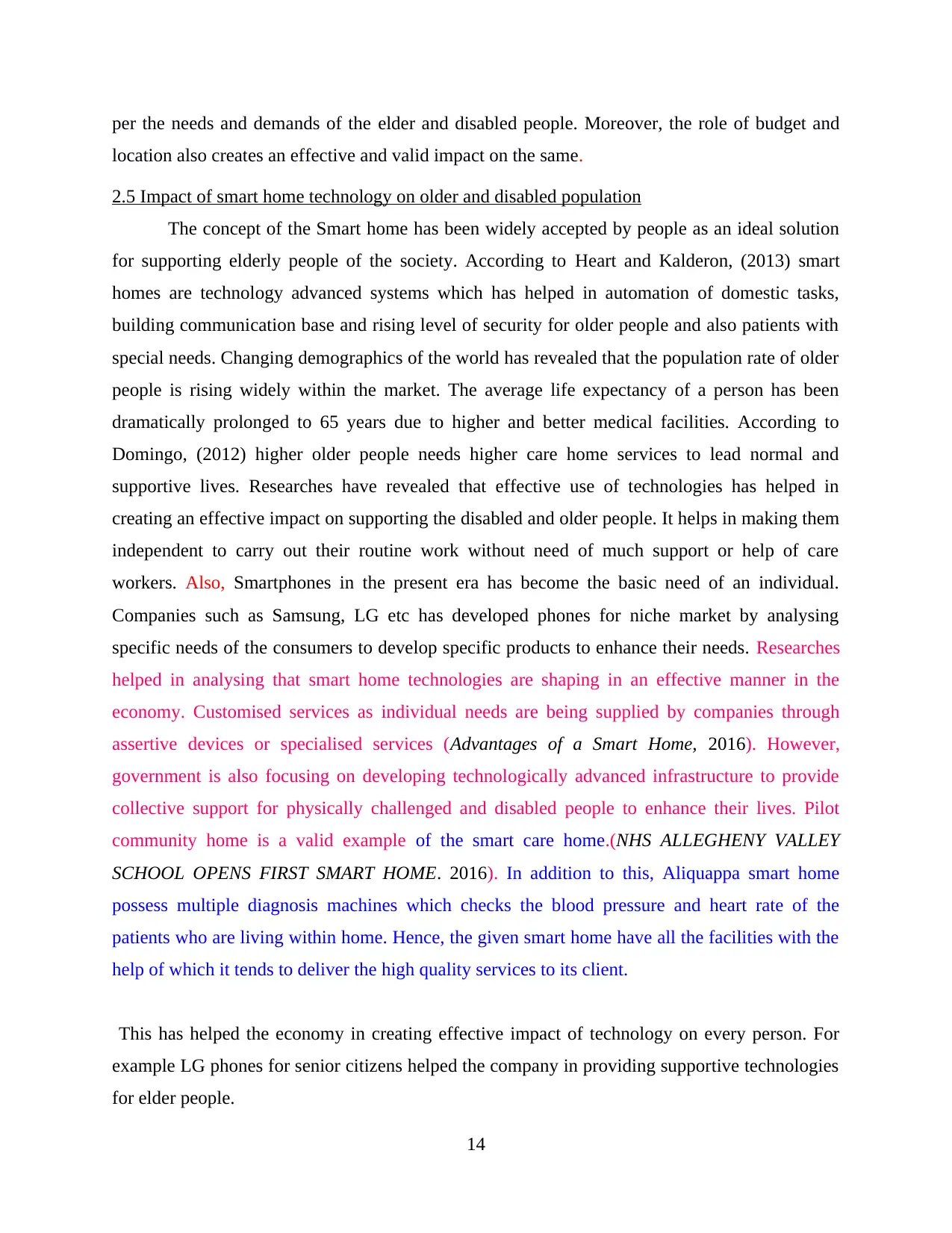
per the needs and demands of the elder and disabled people. Moreover, the role of budget and
location also creates an effective and valid impact on the same.
2.5 Impact of smart home technology on older and disabled population
The concept of the Smart home has been widely accepted by people as an ideal solution
for supporting elderly people of the society. According to Heart and Kalderon, (2013) smart
homes are technology advanced systems which has helped in automation of domestic tasks,
building communication base and rising level of security for older people and also patients with
special needs. Changing demographics of the world has revealed that the population rate of older
people is rising widely within the market. The average life expectancy of a person has been
dramatically prolonged to 65 years due to higher and better medical facilities. According to
Domingo, (2012) higher older people needs higher care home services to lead normal and
supportive lives. Researches have revealed that effective use of technologies has helped in
creating an effective impact on supporting the disabled and older people. It helps in making them
independent to carry out their routine work without need of much support or help of care
workers. Also, Smartphones in the present era has become the basic need of an individual.
Companies such as Samsung, LG etc has developed phones for niche market by analysing
specific needs of the consumers to develop specific products to enhance their needs. Researches
helped in analysing that smart home technologies are shaping in an effective manner in the
economy. Customised services as individual needs are being supplied by companies through
assertive devices or specialised services (Advantages of a Smart Home, 2016). However,
government is also focusing on developing technologically advanced infrastructure to provide
collective support for physically challenged and disabled people to enhance their lives. Pilot
community home is a valid example of the smart care home.(NHS ALLEGHENY VALLEY
SCHOOL OPENS FIRST SMART HOME. 2016). In addition to this, Aliquappa smart home
possess multiple diagnosis machines which checks the blood pressure and heart rate of the
patients who are living within home. Hence, the given smart home have all the facilities with the
help of which it tends to deliver the high quality services to its client.
This has helped the economy in creating effective impact of technology on every person. For
example LG phones for senior citizens helped the company in providing supportive technologies
for elder people.
14
location also creates an effective and valid impact on the same.
2.5 Impact of smart home technology on older and disabled population
The concept of the Smart home has been widely accepted by people as an ideal solution
for supporting elderly people of the society. According to Heart and Kalderon, (2013) smart
homes are technology advanced systems which has helped in automation of domestic tasks,
building communication base and rising level of security for older people and also patients with
special needs. Changing demographics of the world has revealed that the population rate of older
people is rising widely within the market. The average life expectancy of a person has been
dramatically prolonged to 65 years due to higher and better medical facilities. According to
Domingo, (2012) higher older people needs higher care home services to lead normal and
supportive lives. Researches have revealed that effective use of technologies has helped in
creating an effective impact on supporting the disabled and older people. It helps in making them
independent to carry out their routine work without need of much support or help of care
workers. Also, Smartphones in the present era has become the basic need of an individual.
Companies such as Samsung, LG etc has developed phones for niche market by analysing
specific needs of the consumers to develop specific products to enhance their needs. Researches
helped in analysing that smart home technologies are shaping in an effective manner in the
economy. Customised services as individual needs are being supplied by companies through
assertive devices or specialised services (Advantages of a Smart Home, 2016). However,
government is also focusing on developing technologically advanced infrastructure to provide
collective support for physically challenged and disabled people to enhance their lives. Pilot
community home is a valid example of the smart care home.(NHS ALLEGHENY VALLEY
SCHOOL OPENS FIRST SMART HOME. 2016). In addition to this, Aliquappa smart home
possess multiple diagnosis machines which checks the blood pressure and heart rate of the
patients who are living within home. Hence, the given smart home have all the facilities with the
help of which it tends to deliver the high quality services to its client.
This has helped the economy in creating effective impact of technology on every person. For
example LG phones for senior citizens helped the company in providing supportive technologies
for elder people.
14
Paraphrase This Document
Need a fresh take? Get an instant paraphrase of this document with our AI Paraphraser
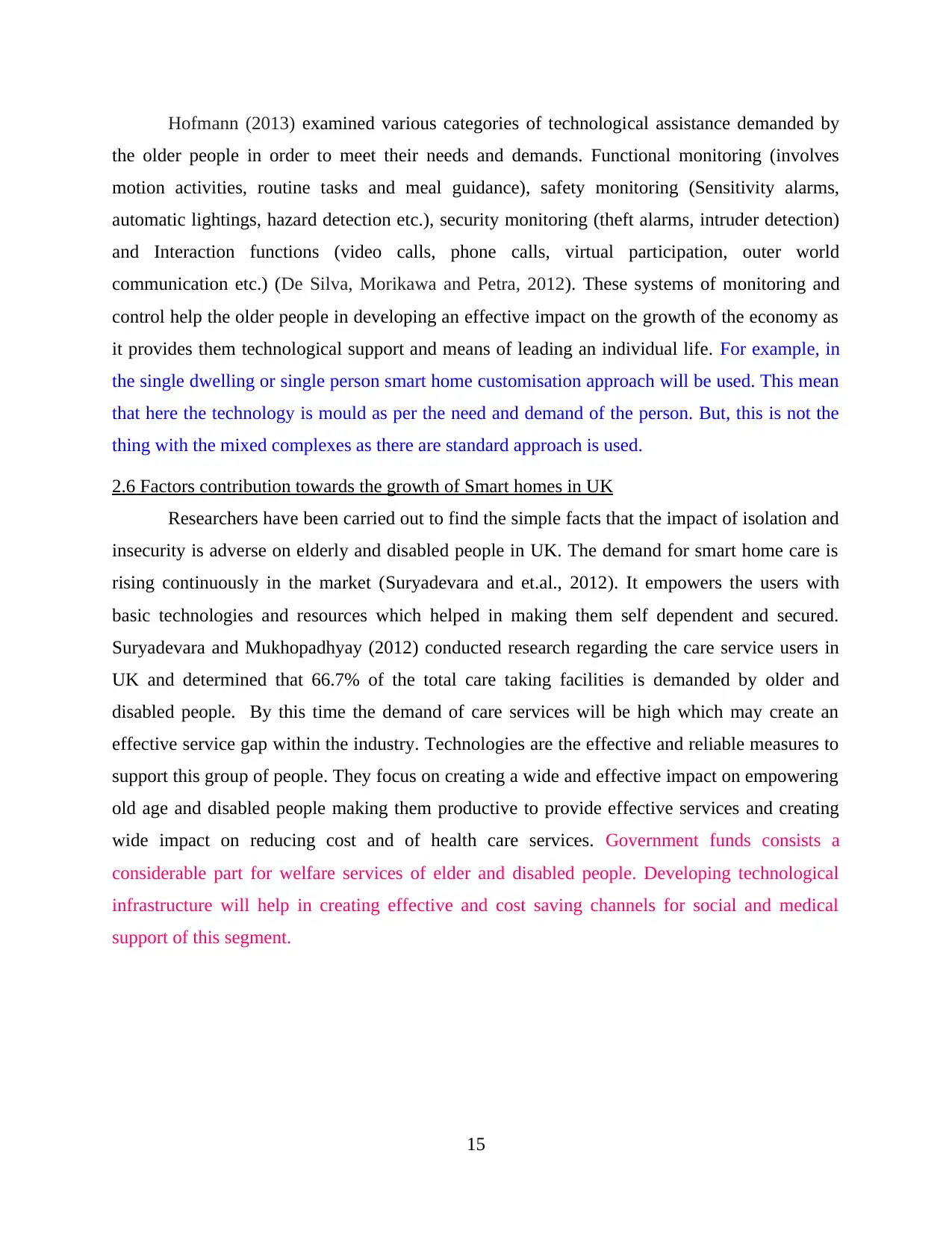
Hofmann (2013) examined various categories of technological assistance demanded by
the older people in order to meet their needs and demands. Functional monitoring (involves
motion activities, routine tasks and meal guidance), safety monitoring (Sensitivity alarms,
automatic lightings, hazard detection etc.), security monitoring (theft alarms, intruder detection)
and Interaction functions (video calls, phone calls, virtual participation, outer world
communication etc.) (De Silva, Morikawa and Petra, 2012). These systems of monitoring and
control help the older people in developing an effective impact on the growth of the economy as
it provides them technological support and means of leading an individual life. For example, in
the single dwelling or single person smart home customisation approach will be used. This mean
that here the technology is mould as per the need and demand of the person. But, this is not the
thing with the mixed complexes as there are standard approach is used.
2.6 Factors contribution towards the growth of Smart homes in UK
Researchers have been carried out to find the simple facts that the impact of isolation and
insecurity is adverse on elderly and disabled people in UK. The demand for smart home care is
rising continuously in the market (Suryadevara and et.al., 2012). It empowers the users with
basic technologies and resources which helped in making them self dependent and secured.
Suryadevara and Mukhopadhyay (2012) conducted research regarding the care service users in
UK and determined that 66.7% of the total care taking facilities is demanded by older and
disabled people. By this time the demand of care services will be high which may create an
effective service gap within the industry. Technologies are the effective and reliable measures to
support this group of people. They focus on creating a wide and effective impact on empowering
old age and disabled people making them productive to provide effective services and creating
wide impact on reducing cost and of health care services. Government funds consists a
considerable part for welfare services of elder and disabled people. Developing technological
infrastructure will help in creating effective and cost saving channels for social and medical
support of this segment.
15
the older people in order to meet their needs and demands. Functional monitoring (involves
motion activities, routine tasks and meal guidance), safety monitoring (Sensitivity alarms,
automatic lightings, hazard detection etc.), security monitoring (theft alarms, intruder detection)
and Interaction functions (video calls, phone calls, virtual participation, outer world
communication etc.) (De Silva, Morikawa and Petra, 2012). These systems of monitoring and
control help the older people in developing an effective impact on the growth of the economy as
it provides them technological support and means of leading an individual life. For example, in
the single dwelling or single person smart home customisation approach will be used. This mean
that here the technology is mould as per the need and demand of the person. But, this is not the
thing with the mixed complexes as there are standard approach is used.
2.6 Factors contribution towards the growth of Smart homes in UK
Researchers have been carried out to find the simple facts that the impact of isolation and
insecurity is adverse on elderly and disabled people in UK. The demand for smart home care is
rising continuously in the market (Suryadevara and et.al., 2012). It empowers the users with
basic technologies and resources which helped in making them self dependent and secured.
Suryadevara and Mukhopadhyay (2012) conducted research regarding the care service users in
UK and determined that 66.7% of the total care taking facilities is demanded by older and
disabled people. By this time the demand of care services will be high which may create an
effective service gap within the industry. Technologies are the effective and reliable measures to
support this group of people. They focus on creating a wide and effective impact on empowering
old age and disabled people making them productive to provide effective services and creating
wide impact on reducing cost and of health care services. Government funds consists a
considerable part for welfare services of elder and disabled people. Developing technological
infrastructure will help in creating effective and cost saving channels for social and medical
support of this segment.
15

Illustration 7: Total government spending (UK)
(Source: The truth about welfare spending: Facts or
propaganda? 2014)
Illustration 8:
Summary of government welfare expenditure (UK)
(Source: The truth about welfare spending: Facts or
propaganda? 2014)
16
(Source: The truth about welfare spending: Facts or
propaganda? 2014)
Illustration 8:
Summary of government welfare expenditure (UK)
(Source: The truth about welfare spending: Facts or
propaganda? 2014)
16

Moreover, the cultural factors of the country reveal that effective use of assertive
technology is the current market demand. In order to attain effective medical and care services in
future, technological impact will have to be enhanced within the economy. In addition to this
Ward and et.al., (2012) revealed the market trends regarding demand of safety, security and
supportive technologies within elder and disabled population will help in developing industrial
growth and development of the country. The concept of smart homes will provide the dependent
population significant support and help to lead a normal life (Balta-Ozkan, and et.al., 2013). In
addition to this, future growth of this part of population will increase care service demand within
the market which will demand technological impact significantly. Hence, the emerging concept
of smart homes for elder and disabled population of UK will be effective and influential. It will
contribute in developing the economy significantly while creating a strong basis for services for
people with special need and support.
2.7 Challenges in implementing smart home technologies for elderly people of UK.
Smart home is an effective and well developed concept for the economy. However, there
are significant ranges of challenges that the industry will have to face to enhance the growth of
the same. The critical reviews regarding the acceptability of the concepts have questioned the
prospects of the development of the concepts. The major challenge that the industry will face
includes financial, technical and psychological factors. These are the major challenges which
have created a wide and effective impact on acceptability of the concept within the economy.
According to Sixsmith, (2013), the concept of smart home demand wide range of
innovative features and designs within a home. Few technologies are cost effective and useful for
the users while few demand high cost of installation and software implementation. In addition to
this Hofmann (2013) questioned on the acceptability and growth of the sector within the
economy asking people about the affordability of the technologies. The access of service to
middle class and lower middle class is a challenge for the economy due to cost factors. In
addition to this it is a well accepted fact that technologies are effectively accepted by young
generation while learning capacity for technology among older generation is slow. This creates a
major challenge for smart homes as the features of the homes are widely based on technology
advanced services and functions (Domingo, 2012). Lack of knowledge for the same and
restrictive adaptability practice may create a wide challenge for the industry to enhance growth
of the stated sector. Psychological barrier among people is also a crucial challenge which may
17
technology is the current market demand. In order to attain effective medical and care services in
future, technological impact will have to be enhanced within the economy. In addition to this
Ward and et.al., (2012) revealed the market trends regarding demand of safety, security and
supportive technologies within elder and disabled population will help in developing industrial
growth and development of the country. The concept of smart homes will provide the dependent
population significant support and help to lead a normal life (Balta-Ozkan, and et.al., 2013). In
addition to this, future growth of this part of population will increase care service demand within
the market which will demand technological impact significantly. Hence, the emerging concept
of smart homes for elder and disabled population of UK will be effective and influential. It will
contribute in developing the economy significantly while creating a strong basis for services for
people with special need and support.
2.7 Challenges in implementing smart home technologies for elderly people of UK.
Smart home is an effective and well developed concept for the economy. However, there
are significant ranges of challenges that the industry will have to face to enhance the growth of
the same. The critical reviews regarding the acceptability of the concepts have questioned the
prospects of the development of the concepts. The major challenge that the industry will face
includes financial, technical and psychological factors. These are the major challenges which
have created a wide and effective impact on acceptability of the concept within the economy.
According to Sixsmith, (2013), the concept of smart home demand wide range of
innovative features and designs within a home. Few technologies are cost effective and useful for
the users while few demand high cost of installation and software implementation. In addition to
this Hofmann (2013) questioned on the acceptability and growth of the sector within the
economy asking people about the affordability of the technologies. The access of service to
middle class and lower middle class is a challenge for the economy due to cost factors. In
addition to this it is a well accepted fact that technologies are effectively accepted by young
generation while learning capacity for technology among older generation is slow. This creates a
major challenge for smart homes as the features of the homes are widely based on technology
advanced services and functions (Domingo, 2012). Lack of knowledge for the same and
restrictive adaptability practice may create a wide challenge for the industry to enhance growth
of the stated sector. Psychological barrier among people is also a crucial challenge which may
17
Secure Best Marks with AI Grader
Need help grading? Try our AI Grader for instant feedback on your assignments.
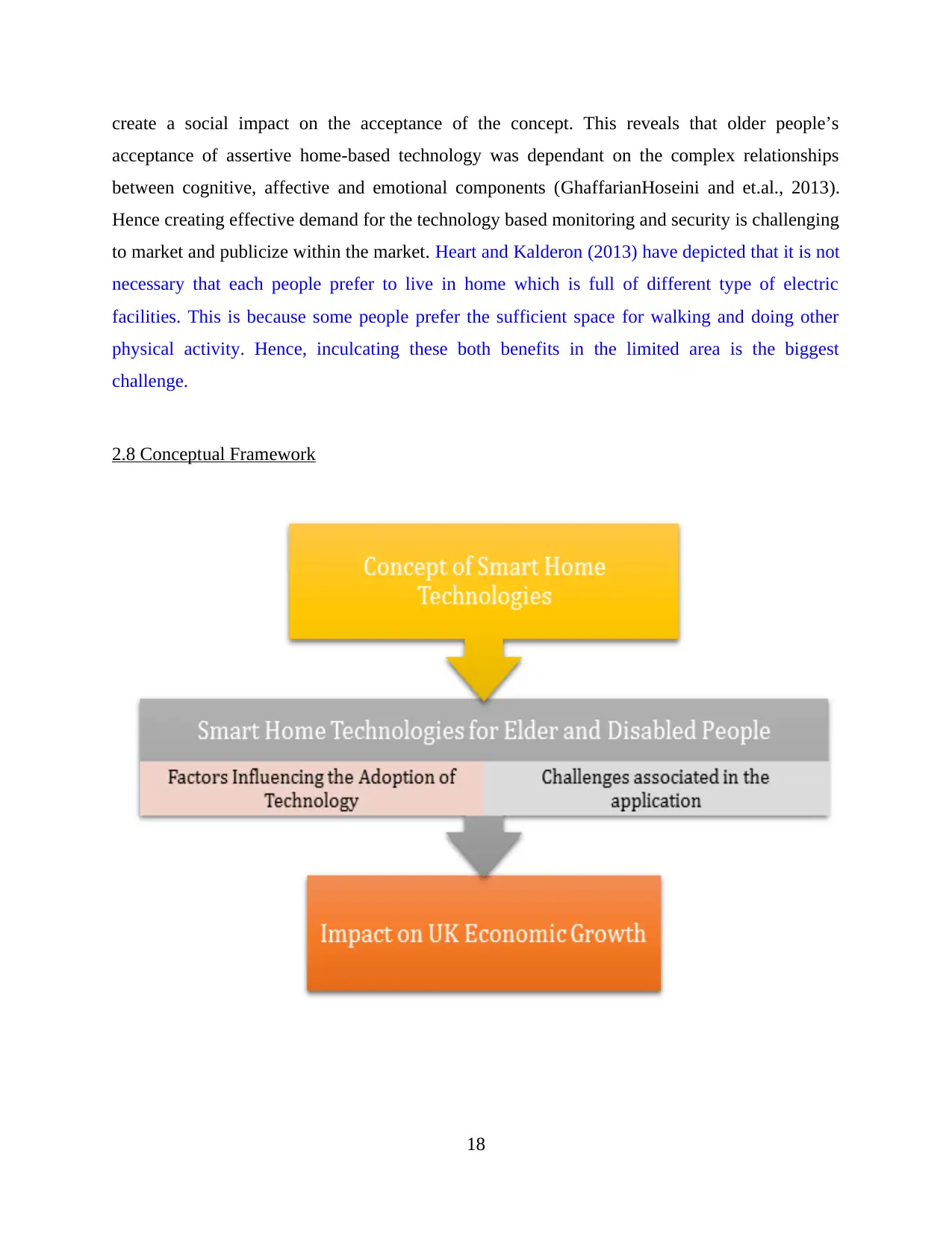
create a social impact on the acceptance of the concept. This reveals that older people’s
acceptance of assertive home-based technology was dependant on the complex relationships
between cognitive, affective and emotional components (GhaffarianHoseini and et.al., 2013).
Hence creating effective demand for the technology based monitoring and security is challenging
to market and publicize within the market. Heart and Kalderon (2013) have depicted that it is not
necessary that each people prefer to live in home which is full of different type of electric
facilities. This is because some people prefer the sufficient space for walking and doing other
physical activity. Hence, inculcating these both benefits in the limited area is the biggest
challenge.
2.8 Conceptual Framework
18
acceptance of assertive home-based technology was dependant on the complex relationships
between cognitive, affective and emotional components (GhaffarianHoseini and et.al., 2013).
Hence creating effective demand for the technology based monitoring and security is challenging
to market and publicize within the market. Heart and Kalderon (2013) have depicted that it is not
necessary that each people prefer to live in home which is full of different type of electric
facilities. This is because some people prefer the sufficient space for walking and doing other
physical activity. Hence, inculcating these both benefits in the limited area is the biggest
challenge.
2.8 Conceptual Framework
18
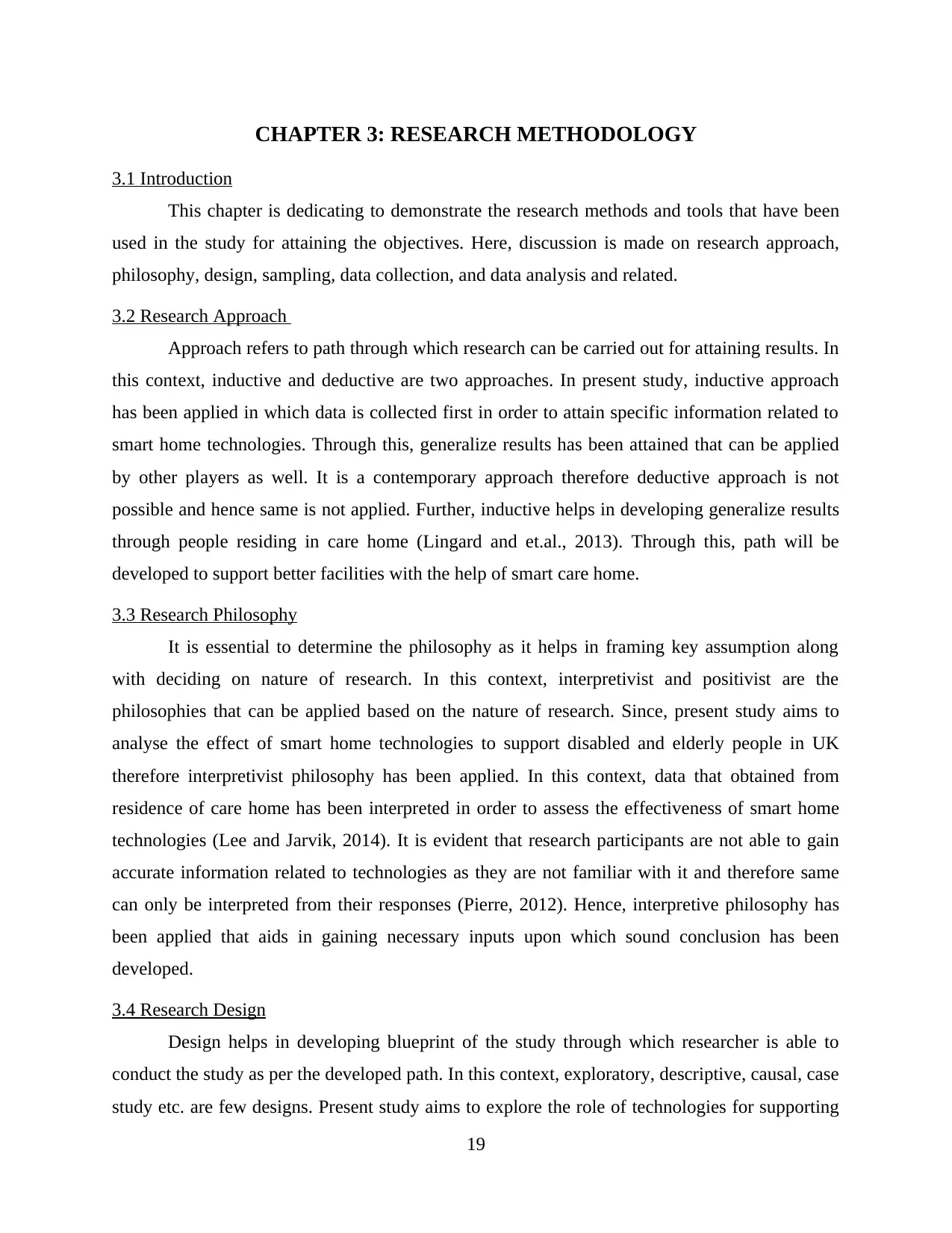
CHAPTER 3: RESEARCH METHODOLOGY
3.1 Introduction
This chapter is dedicating to demonstrate the research methods and tools that have been
used in the study for attaining the objectives. Here, discussion is made on research approach,
philosophy, design, sampling, data collection, and data analysis and related.
3.2 Research Approach
Approach refers to path through which research can be carried out for attaining results. In
this context, inductive and deductive are two approaches. In present study, inductive approach
has been applied in which data is collected first in order to attain specific information related to
smart home technologies. Through this, generalize results has been attained that can be applied
by other players as well. It is a contemporary approach therefore deductive approach is not
possible and hence same is not applied. Further, inductive helps in developing generalize results
through people residing in care home (Lingard and et.al., 2013). Through this, path will be
developed to support better facilities with the help of smart care home.
3.3 Research Philosophy
It is essential to determine the philosophy as it helps in framing key assumption along
with deciding on nature of research. In this context, interpretivist and positivist are the
philosophies that can be applied based on the nature of research. Since, present study aims to
analyse the effect of smart home technologies to support disabled and elderly people in UK
therefore interpretivist philosophy has been applied. In this context, data that obtained from
residence of care home has been interpreted in order to assess the effectiveness of smart home
technologies (Lee and Jarvik, 2014). It is evident that research participants are not able to gain
accurate information related to technologies as they are not familiar with it and therefore same
can only be interpreted from their responses (Pierre, 2012). Hence, interpretive philosophy has
been applied that aids in gaining necessary inputs upon which sound conclusion has been
developed.
3.4 Research Design
Design helps in developing blueprint of the study through which researcher is able to
conduct the study as per the developed path. In this context, exploratory, descriptive, causal, case
study etc. are few designs. Present study aims to explore the role of technologies for supporting
19
3.1 Introduction
This chapter is dedicating to demonstrate the research methods and tools that have been
used in the study for attaining the objectives. Here, discussion is made on research approach,
philosophy, design, sampling, data collection, and data analysis and related.
3.2 Research Approach
Approach refers to path through which research can be carried out for attaining results. In
this context, inductive and deductive are two approaches. In present study, inductive approach
has been applied in which data is collected first in order to attain specific information related to
smart home technologies. Through this, generalize results has been attained that can be applied
by other players as well. It is a contemporary approach therefore deductive approach is not
possible and hence same is not applied. Further, inductive helps in developing generalize results
through people residing in care home (Lingard and et.al., 2013). Through this, path will be
developed to support better facilities with the help of smart care home.
3.3 Research Philosophy
It is essential to determine the philosophy as it helps in framing key assumption along
with deciding on nature of research. In this context, interpretivist and positivist are the
philosophies that can be applied based on the nature of research. Since, present study aims to
analyse the effect of smart home technologies to support disabled and elderly people in UK
therefore interpretivist philosophy has been applied. In this context, data that obtained from
residence of care home has been interpreted in order to assess the effectiveness of smart home
technologies (Lee and Jarvik, 2014). It is evident that research participants are not able to gain
accurate information related to technologies as they are not familiar with it and therefore same
can only be interpreted from their responses (Pierre, 2012). Hence, interpretive philosophy has
been applied that aids in gaining necessary inputs upon which sound conclusion has been
developed.
3.4 Research Design
Design helps in developing blueprint of the study through which researcher is able to
conduct the study as per the developed path. In this context, exploratory, descriptive, causal, case
study etc. are few designs. Present study aims to explore the role of technologies for supporting
19
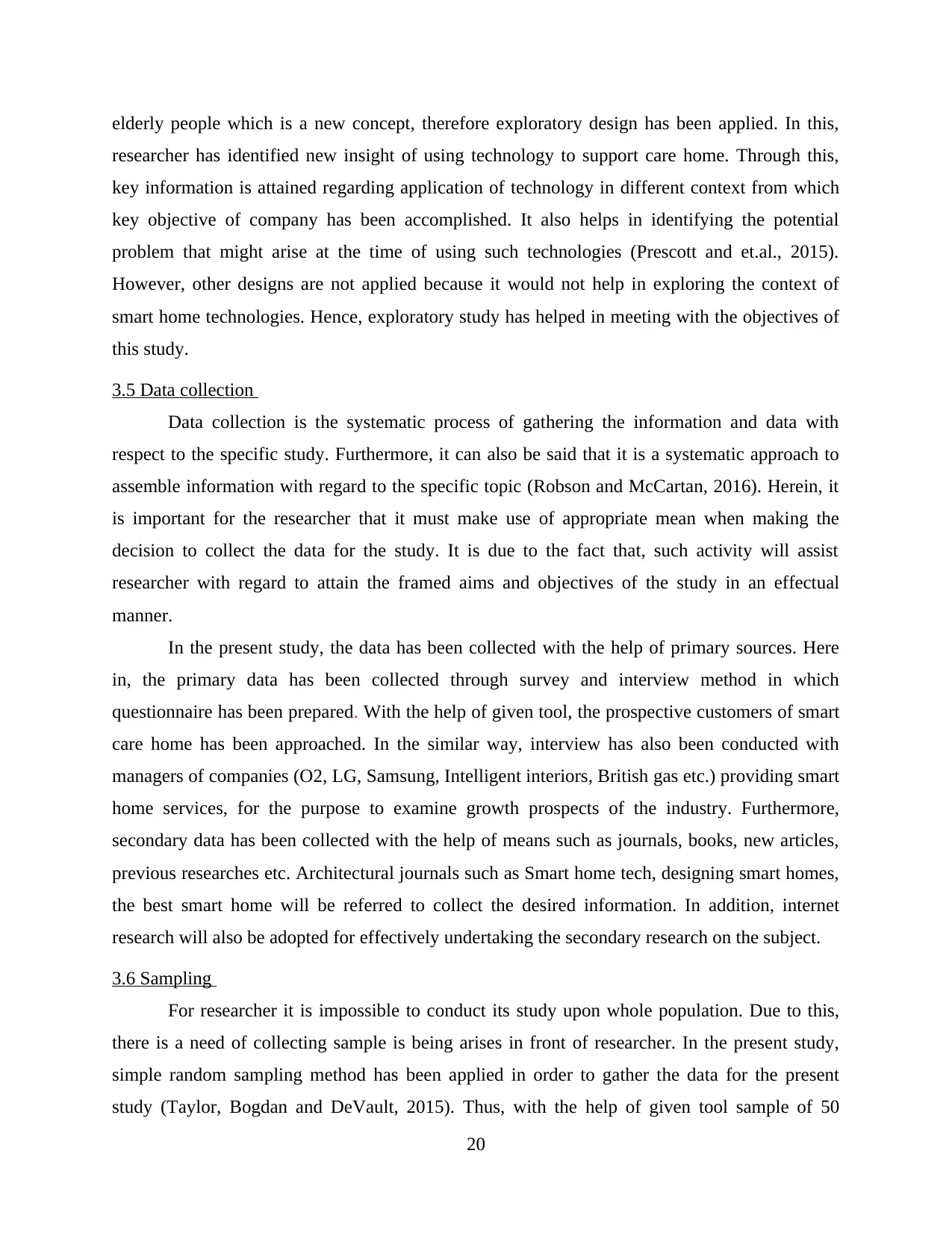
elderly people which is a new concept, therefore exploratory design has been applied. In this,
researcher has identified new insight of using technology to support care home. Through this,
key information is attained regarding application of technology in different context from which
key objective of company has been accomplished. It also helps in identifying the potential
problem that might arise at the time of using such technologies (Prescott and et.al., 2015).
However, other designs are not applied because it would not help in exploring the context of
smart home technologies. Hence, exploratory study has helped in meeting with the objectives of
this study.
3.5 Data collection
Data collection is the systematic process of gathering the information and data with
respect to the specific study. Furthermore, it can also be said that it is a systematic approach to
assemble information with regard to the specific topic (Robson and McCartan, 2016). Herein, it
is important for the researcher that it must make use of appropriate mean when making the
decision to collect the data for the study. It is due to the fact that, such activity will assist
researcher with regard to attain the framed aims and objectives of the study in an effectual
manner.
In the present study, the data has been collected with the help of primary sources. Here
in, the primary data has been collected through survey and interview method in which
questionnaire has been prepared. With the help of given tool, the prospective customers of smart
care home has been approached. In the similar way, interview has also been conducted with
managers of companies (O2, LG, Samsung, Intelligent interiors, British gas etc.) providing smart
home services, for the purpose to examine growth prospects of the industry. Furthermore,
secondary data has been collected with the help of means such as journals, books, new articles,
previous researches etc. Architectural journals such as Smart home tech, designing smart homes,
the best smart home will be referred to collect the desired information. In addition, internet
research will also be adopted for effectively undertaking the secondary research on the subject.
3.6 Sampling
For researcher it is impossible to conduct its study upon whole population. Due to this,
there is a need of collecting sample is being arises in front of researcher. In the present study,
simple random sampling method has been applied in order to gather the data for the present
study (Taylor, Bogdan and DeVault, 2015). Thus, with the help of given tool sample of 50
20
researcher has identified new insight of using technology to support care home. Through this,
key information is attained regarding application of technology in different context from which
key objective of company has been accomplished. It also helps in identifying the potential
problem that might arise at the time of using such technologies (Prescott and et.al., 2015).
However, other designs are not applied because it would not help in exploring the context of
smart home technologies. Hence, exploratory study has helped in meeting with the objectives of
this study.
3.5 Data collection
Data collection is the systematic process of gathering the information and data with
respect to the specific study. Furthermore, it can also be said that it is a systematic approach to
assemble information with regard to the specific topic (Robson and McCartan, 2016). Herein, it
is important for the researcher that it must make use of appropriate mean when making the
decision to collect the data for the study. It is due to the fact that, such activity will assist
researcher with regard to attain the framed aims and objectives of the study in an effectual
manner.
In the present study, the data has been collected with the help of primary sources. Here
in, the primary data has been collected through survey and interview method in which
questionnaire has been prepared. With the help of given tool, the prospective customers of smart
care home has been approached. In the similar way, interview has also been conducted with
managers of companies (O2, LG, Samsung, Intelligent interiors, British gas etc.) providing smart
home services, for the purpose to examine growth prospects of the industry. Furthermore,
secondary data has been collected with the help of means such as journals, books, new articles,
previous researches etc. Architectural journals such as Smart home tech, designing smart homes,
the best smart home will be referred to collect the desired information. In addition, internet
research will also be adopted for effectively undertaking the secondary research on the subject.
3.6 Sampling
For researcher it is impossible to conduct its study upon whole population. Due to this,
there is a need of collecting sample is being arises in front of researcher. In the present study,
simple random sampling method has been applied in order to gather the data for the present
study (Taylor, Bogdan and DeVault, 2015). Thus, with the help of given tool sample of 50
20
Paraphrase This Document
Need a fresh take? Get an instant paraphrase of this document with our AI Paraphraser

people residing in care home has been selected. By conducting research upon the given sample
the framed aim and objectives of the study has been met effectively. For interview 15 managers
from different companies were selected and approached on the convenience basis and a well-
structured interview will be undertaken in an ethical manner.
3.7 Data analysis
It is required by the scholar that it should make use of appropriate technique in order to
analyse the collected data for its study. This is because, if it is not done then framed objectives of
the study will not being met (Mackey and Gass, 2015). Here, in the present study the collected
data has been analysed with the help of thematic tool. In this regard, the data has been analysed
by preparing varied themes. Furthermore, the collected data has been presented with the help of
graphs and charts.
3.8 Reliability and Validity
In this research, focus is laid on reliability and validity of data as well for attaining key
objectives. For this purpose, data has been collected from authentic and reputable source only.
Further, publisher name and ISBN number have been reviewed for the same. Additionally,
sufficient sample is assured that aids in gaining reliable information. Moreover, smart home
technologies are a contemporary approach and therefore latest data has been used in the study in
order to ensure validity (Flick, 2015).
21
the framed aim and objectives of the study has been met effectively. For interview 15 managers
from different companies were selected and approached on the convenience basis and a well-
structured interview will be undertaken in an ethical manner.
3.7 Data analysis
It is required by the scholar that it should make use of appropriate technique in order to
analyse the collected data for its study. This is because, if it is not done then framed objectives of
the study will not being met (Mackey and Gass, 2015). Here, in the present study the collected
data has been analysed with the help of thematic tool. In this regard, the data has been analysed
by preparing varied themes. Furthermore, the collected data has been presented with the help of
graphs and charts.
3.8 Reliability and Validity
In this research, focus is laid on reliability and validity of data as well for attaining key
objectives. For this purpose, data has been collected from authentic and reputable source only.
Further, publisher name and ISBN number have been reviewed for the same. Additionally,
sufficient sample is assured that aids in gaining reliable information. Moreover, smart home
technologies are a contemporary approach and therefore latest data has been used in the study in
order to ensure validity (Flick, 2015).
21
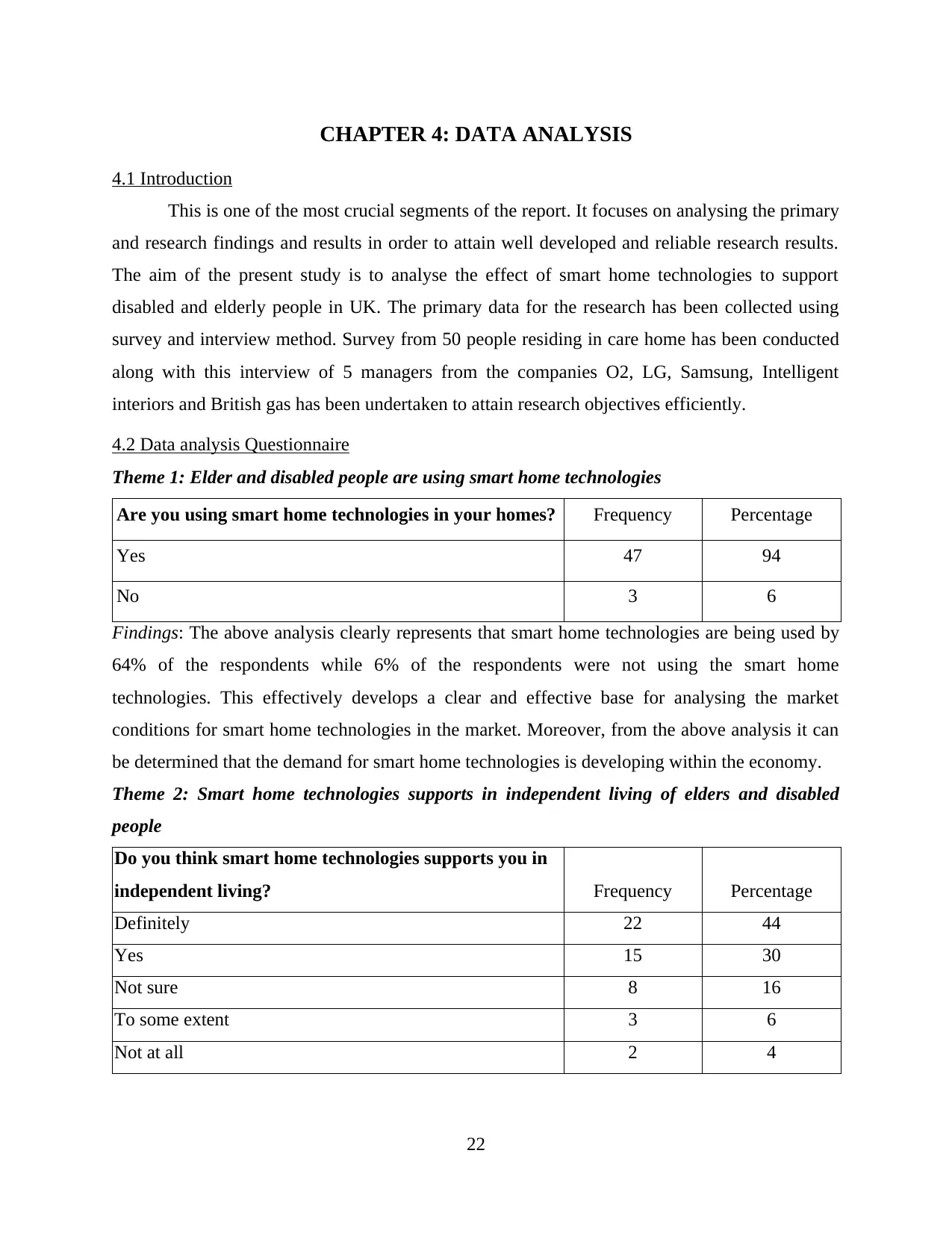
CHAPTER 4: DATA ANALYSIS
4.1 Introduction
This is one of the most crucial segments of the report. It focuses on analysing the primary
and research findings and results in order to attain well developed and reliable research results.
The aim of the present study is to analyse the effect of smart home technologies to support
disabled and elderly people in UK. The primary data for the research has been collected using
survey and interview method. Survey from 50 people residing in care home has been conducted
along with this interview of 5 managers from the companies O2, LG, Samsung, Intelligent
interiors and British gas has been undertaken to attain research objectives efficiently.
4.2 Data analysis Questionnaire
Theme 1: Elder and disabled people are using smart home technologies
Are you using smart home technologies in your homes? Frequency Percentage
Yes 47 94
No 3 6
Findings: The above analysis clearly represents that smart home technologies are being used by
64% of the respondents while 6% of the respondents were not using the smart home
technologies. This effectively develops a clear and effective base for analysing the market
conditions for smart home technologies in the market. Moreover, from the above analysis it can
be determined that the demand for smart home technologies is developing within the economy.
Theme 2: Smart home technologies supports in independent living of elders and disabled
people
Do you think smart home technologies supports you in
independent living? Frequency Percentage
Definitely 22 44
Yes 15 30
Not sure 8 16
To some extent 3 6
Not at all 2 4
22
4.1 Introduction
This is one of the most crucial segments of the report. It focuses on analysing the primary
and research findings and results in order to attain well developed and reliable research results.
The aim of the present study is to analyse the effect of smart home technologies to support
disabled and elderly people in UK. The primary data for the research has been collected using
survey and interview method. Survey from 50 people residing in care home has been conducted
along with this interview of 5 managers from the companies O2, LG, Samsung, Intelligent
interiors and British gas has been undertaken to attain research objectives efficiently.
4.2 Data analysis Questionnaire
Theme 1: Elder and disabled people are using smart home technologies
Are you using smart home technologies in your homes? Frequency Percentage
Yes 47 94
No 3 6
Findings: The above analysis clearly represents that smart home technologies are being used by
64% of the respondents while 6% of the respondents were not using the smart home
technologies. This effectively develops a clear and effective base for analysing the market
conditions for smart home technologies in the market. Moreover, from the above analysis it can
be determined that the demand for smart home technologies is developing within the economy.
Theme 2: Smart home technologies supports in independent living of elders and disabled
people
Do you think smart home technologies supports you in
independent living? Frequency Percentage
Definitely 22 44
Yes 15 30
Not sure 8 16
To some extent 3 6
Not at all 2 4
22
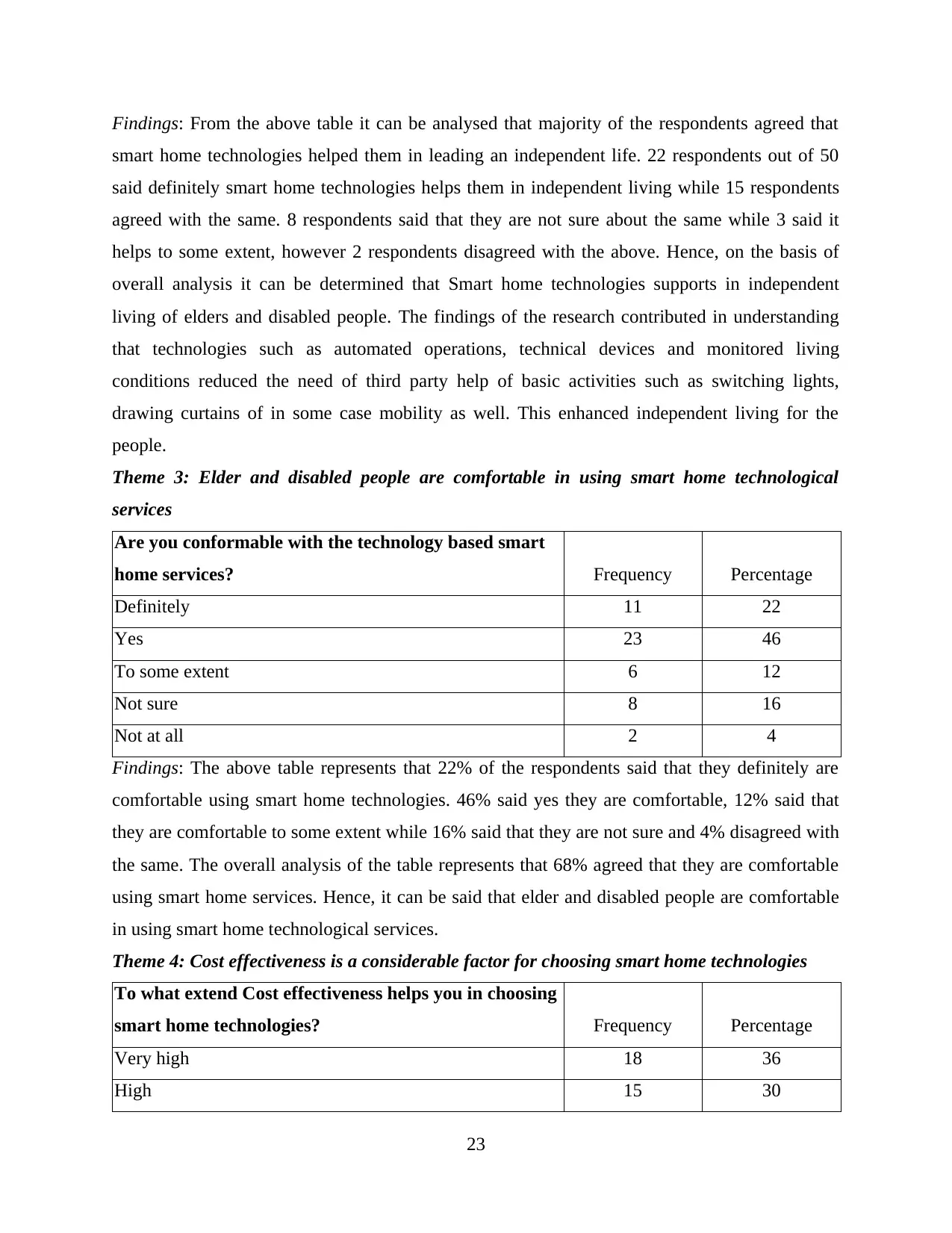
Findings: From the above table it can be analysed that majority of the respondents agreed that
smart home technologies helped them in leading an independent life. 22 respondents out of 50
said definitely smart home technologies helps them in independent living while 15 respondents
agreed with the same. 8 respondents said that they are not sure about the same while 3 said it
helps to some extent, however 2 respondents disagreed with the above. Hence, on the basis of
overall analysis it can be determined that Smart home technologies supports in independent
living of elders and disabled people. The findings of the research contributed in understanding
that technologies such as automated operations, technical devices and monitored living
conditions reduced the need of third party help of basic activities such as switching lights,
drawing curtains of in some case mobility as well. This enhanced independent living for the
people.
Theme 3: Elder and disabled people are comfortable in using smart home technological
services
Are you conformable with the technology based smart
home services? Frequency Percentage
Definitely 11 22
Yes 23 46
To some extent 6 12
Not sure 8 16
Not at all 2 4
Findings: The above table represents that 22% of the respondents said that they definitely are
comfortable using smart home technologies. 46% said yes they are comfortable, 12% said that
they are comfortable to some extent while 16% said that they are not sure and 4% disagreed with
the same. The overall analysis of the table represents that 68% agreed that they are comfortable
using smart home services. Hence, it can be said that elder and disabled people are comfortable
in using smart home technological services.
Theme 4: Cost effectiveness is a considerable factor for choosing smart home technologies
To what extend Cost effectiveness helps you in choosing
smart home technologies? Frequency Percentage
Very high 18 36
High 15 30
23
smart home technologies helped them in leading an independent life. 22 respondents out of 50
said definitely smart home technologies helps them in independent living while 15 respondents
agreed with the same. 8 respondents said that they are not sure about the same while 3 said it
helps to some extent, however 2 respondents disagreed with the above. Hence, on the basis of
overall analysis it can be determined that Smart home technologies supports in independent
living of elders and disabled people. The findings of the research contributed in understanding
that technologies such as automated operations, technical devices and monitored living
conditions reduced the need of third party help of basic activities such as switching lights,
drawing curtains of in some case mobility as well. This enhanced independent living for the
people.
Theme 3: Elder and disabled people are comfortable in using smart home technological
services
Are you conformable with the technology based smart
home services? Frequency Percentage
Definitely 11 22
Yes 23 46
To some extent 6 12
Not sure 8 16
Not at all 2 4
Findings: The above table represents that 22% of the respondents said that they definitely are
comfortable using smart home technologies. 46% said yes they are comfortable, 12% said that
they are comfortable to some extent while 16% said that they are not sure and 4% disagreed with
the same. The overall analysis of the table represents that 68% agreed that they are comfortable
using smart home services. Hence, it can be said that elder and disabled people are comfortable
in using smart home technological services.
Theme 4: Cost effectiveness is a considerable factor for choosing smart home technologies
To what extend Cost effectiveness helps you in choosing
smart home technologies? Frequency Percentage
Very high 18 36
High 15 30
23
Secure Best Marks with AI Grader
Need help grading? Try our AI Grader for instant feedback on your assignments.

Average 9 18
Low 5 10
Very low 3 6
Findings: The above analysis reflects that 36% of the respondents said that cost effectiveness
plays a very high role while 30% said it played high role for the same. For 18% respondents cost
effectiveness played average role while for 10% cost effectiveness played low role and for 6% it
played a very low role in choosing services. Hence, from the overall analysis it can be said that
cost effectiveness is a considerable factor for choosing smart home technologies within elder and
disabled people.
Theme 5: Convenience of users plays a significant role in developing demand for smart home
technologies
To what extend Convenience helps you in choosing
smart home technologies? Frequency Percentage
Very high 16 32
High 17 34
Average 10 20
Low 6 12
Very low 1 2
Findings: the above table helps in analysing that 32% of the respondents believed that
convenience plays a very high role in choosing smart home technology 34% of the respondents
said it played high role in making adopting smart home technologies. 20% of the respondents
said that convenience plays an average role for the same. However, 12% of the respondents said
that it plays low and 2% said that it plays very low role in choosing smart home technologies.
Thus, on the basis of overall analysis it can be effectively analysed that convenience is a
considerable factor for elder and disabled people. Theme 6: Smart home technologies help in
attaining high medical support and independence
Smart home technologies help in attaining high medical
support and independence to me. Frequency Percentage
Highly agree 22 44
Agree 18 36
Neutral 8 16
24
Low 5 10
Very low 3 6
Findings: The above analysis reflects that 36% of the respondents said that cost effectiveness
plays a very high role while 30% said it played high role for the same. For 18% respondents cost
effectiveness played average role while for 10% cost effectiveness played low role and for 6% it
played a very low role in choosing services. Hence, from the overall analysis it can be said that
cost effectiveness is a considerable factor for choosing smart home technologies within elder and
disabled people.
Theme 5: Convenience of users plays a significant role in developing demand for smart home
technologies
To what extend Convenience helps you in choosing
smart home technologies? Frequency Percentage
Very high 16 32
High 17 34
Average 10 20
Low 6 12
Very low 1 2
Findings: the above table helps in analysing that 32% of the respondents believed that
convenience plays a very high role in choosing smart home technology 34% of the respondents
said it played high role in making adopting smart home technologies. 20% of the respondents
said that convenience plays an average role for the same. However, 12% of the respondents said
that it plays low and 2% said that it plays very low role in choosing smart home technologies.
Thus, on the basis of overall analysis it can be effectively analysed that convenience is a
considerable factor for elder and disabled people. Theme 6: Smart home technologies help in
attaining high medical support and independence
Smart home technologies help in attaining high medical
support and independence to me. Frequency Percentage
Highly agree 22 44
Agree 18 36
Neutral 8 16
24
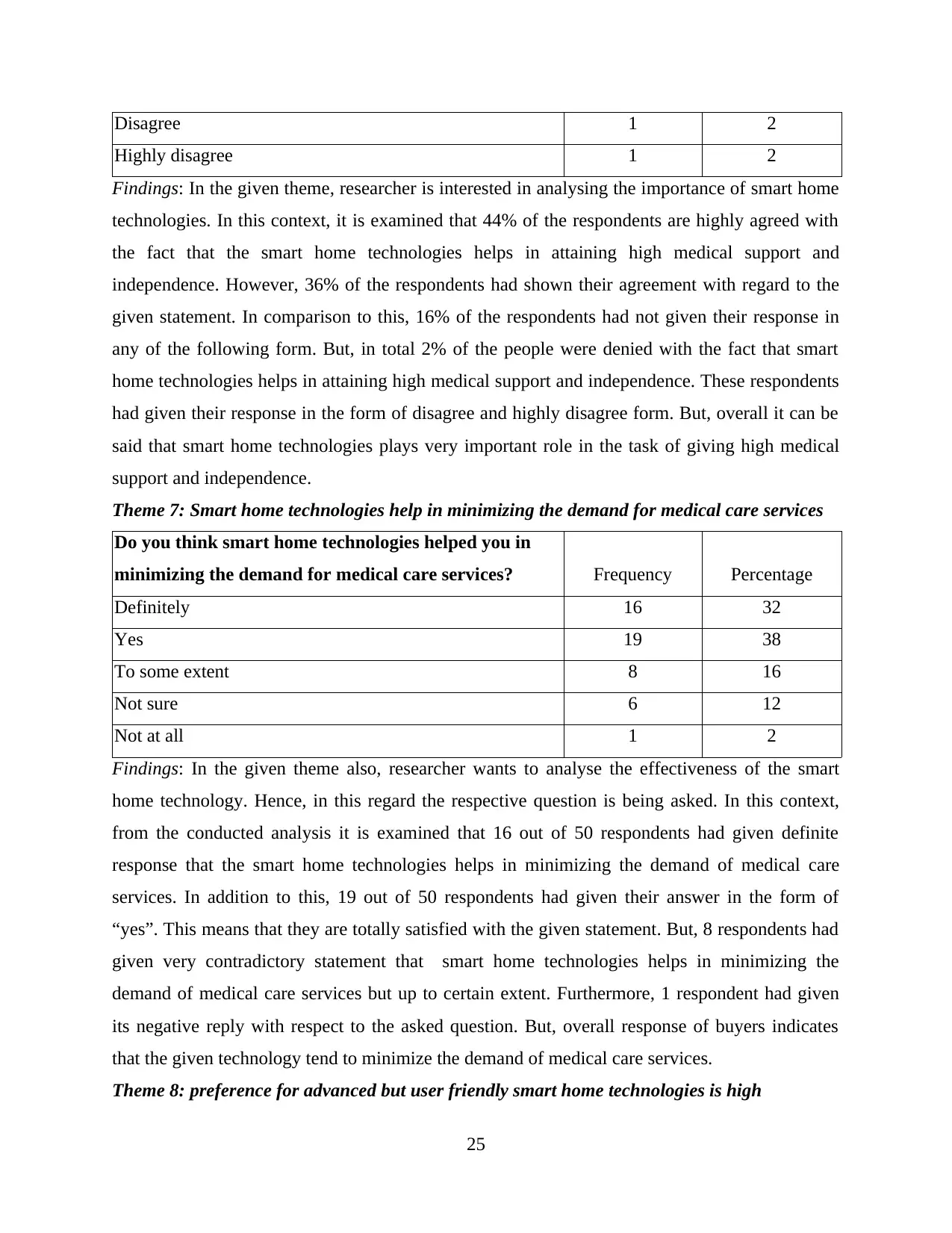
Disagree 1 2
Highly disagree 1 2
Findings: In the given theme, researcher is interested in analysing the importance of smart home
technologies. In this context, it is examined that 44% of the respondents are highly agreed with
the fact that the smart home technologies helps in attaining high medical support and
independence. However, 36% of the respondents had shown their agreement with regard to the
given statement. In comparison to this, 16% of the respondents had not given their response in
any of the following form. But, in total 2% of the people were denied with the fact that smart
home technologies helps in attaining high medical support and independence. These respondents
had given their response in the form of disagree and highly disagree form. But, overall it can be
said that smart home technologies plays very important role in the task of giving high medical
support and independence.
Theme 7: Smart home technologies help in minimizing the demand for medical care services
Do you think smart home technologies helped you in
minimizing the demand for medical care services? Frequency Percentage
Definitely 16 32
Yes 19 38
To some extent 8 16
Not sure 6 12
Not at all 1 2
Findings: In the given theme also, researcher wants to analyse the effectiveness of the smart
home technology. Hence, in this regard the respective question is being asked. In this context,
from the conducted analysis it is examined that 16 out of 50 respondents had given definite
response that the smart home technologies helps in minimizing the demand of medical care
services. In addition to this, 19 out of 50 respondents had given their answer in the form of
“yes”. This means that they are totally satisfied with the given statement. But, 8 respondents had
given very contradictory statement that smart home technologies helps in minimizing the
demand of medical care services but up to certain extent. Furthermore, 1 respondent had given
its negative reply with respect to the asked question. But, overall response of buyers indicates
that the given technology tend to minimize the demand of medical care services.
Theme 8: preference for advanced but user friendly smart home technologies is high
25
Highly disagree 1 2
Findings: In the given theme, researcher is interested in analysing the importance of smart home
technologies. In this context, it is examined that 44% of the respondents are highly agreed with
the fact that the smart home technologies helps in attaining high medical support and
independence. However, 36% of the respondents had shown their agreement with regard to the
given statement. In comparison to this, 16% of the respondents had not given their response in
any of the following form. But, in total 2% of the people were denied with the fact that smart
home technologies helps in attaining high medical support and independence. These respondents
had given their response in the form of disagree and highly disagree form. But, overall it can be
said that smart home technologies plays very important role in the task of giving high medical
support and independence.
Theme 7: Smart home technologies help in minimizing the demand for medical care services
Do you think smart home technologies helped you in
minimizing the demand for medical care services? Frequency Percentage
Definitely 16 32
Yes 19 38
To some extent 8 16
Not sure 6 12
Not at all 1 2
Findings: In the given theme also, researcher wants to analyse the effectiveness of the smart
home technology. Hence, in this regard the respective question is being asked. In this context,
from the conducted analysis it is examined that 16 out of 50 respondents had given definite
response that the smart home technologies helps in minimizing the demand of medical care
services. In addition to this, 19 out of 50 respondents had given their answer in the form of
“yes”. This means that they are totally satisfied with the given statement. But, 8 respondents had
given very contradictory statement that smart home technologies helps in minimizing the
demand of medical care services but up to certain extent. Furthermore, 1 respondent had given
its negative reply with respect to the asked question. But, overall response of buyers indicates
that the given technology tend to minimize the demand of medical care services.
Theme 8: preference for advanced but user friendly smart home technologies is high
25

Will you prefer advanced but user friendly smart home
technologies for your future needs? Frequency Percentage
Definitely 17 34
Yes 18 36
To some extent 5 10
Not sure 8 16
Not at all 2 4
Findings: Here, from the conducted analysis it is examined that majority of respondents had
given their response in the form of yes which indicate that they prefer for the advanced but user
friendly smart home technology. In addition to this, 17 respondents were also complied with the
given statement. In addition to this, 8 out of 50 respondents were not sure about the statement
that whether they prefer to use advanced but user friendly smart home technology. Furthermore,
2 respondents were denied with the given statement. Overall, from the conducted analysis it is
assessed majority of buyers wants to use advanced technology but the technology should be user
friendly.
4.3 Data analysis Interview
The interview conducted from 15 managers of the companies providing smart home
services in the market helped in attaining valuable results for attaining research findings. The
following themes reflect the analysis of the same.
Theme 1: Economic and demographic factors contributes demand for smart home
technologies
Are economic and demographic factors supporting demand
for smart home technologies for elder and disabled people? Frequency Percentage
Definitely 4 27%
Yes 5 33%
To some extent 2 13%
Not sure 3 20%
26
technologies for your future needs? Frequency Percentage
Definitely 17 34
Yes 18 36
To some extent 5 10
Not sure 8 16
Not at all 2 4
Findings: Here, from the conducted analysis it is examined that majority of respondents had
given their response in the form of yes which indicate that they prefer for the advanced but user
friendly smart home technology. In addition to this, 17 respondents were also complied with the
given statement. In addition to this, 8 out of 50 respondents were not sure about the statement
that whether they prefer to use advanced but user friendly smart home technology. Furthermore,
2 respondents were denied with the given statement. Overall, from the conducted analysis it is
assessed majority of buyers wants to use advanced technology but the technology should be user
friendly.
4.3 Data analysis Interview
The interview conducted from 15 managers of the companies providing smart home
services in the market helped in attaining valuable results for attaining research findings. The
following themes reflect the analysis of the same.
Theme 1: Economic and demographic factors contributes demand for smart home
technologies
Are economic and demographic factors supporting demand
for smart home technologies for elder and disabled people? Frequency Percentage
Definitely 4 27%
Yes 5 33%
To some extent 2 13%
Not sure 3 20%
26
Paraphrase This Document
Need a fresh take? Get an instant paraphrase of this document with our AI Paraphraser
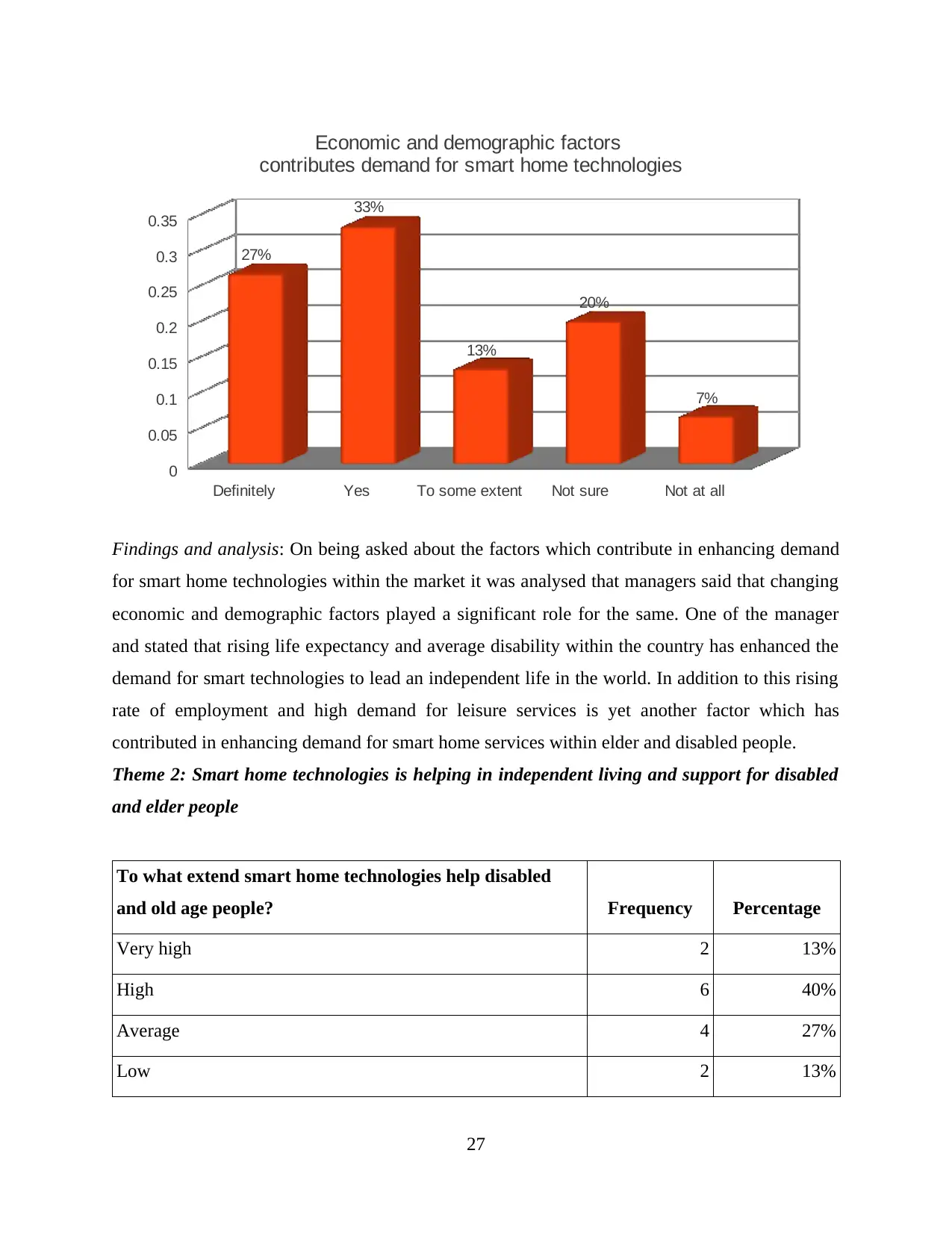
Definitely Yes To some extent Not sure Not at all
0
0.05
0.1
0.15
0.2
0.25
0.3
0.35
27%
33%
13%
20%
7%
Economic and demographic factors
contributes demand for smart home technologies
Findings and analysis: On being asked about the factors which contribute in enhancing demand
for smart home technologies within the market it was analysed that managers said that changing
economic and demographic factors played a significant role for the same. One of the manager
and stated that rising life expectancy and average disability within the country has enhanced the
demand for smart technologies to lead an independent life in the world. In addition to this rising
rate of employment and high demand for leisure services is yet another factor which has
contributed in enhancing demand for smart home services within elder and disabled people.
Theme 2: Smart home technologies is helping in independent living and support for disabled
and elder people
To what extend smart home technologies help disabled
and old age people? Frequency Percentage
Very high 2 13%
High 6 40%
Average 4 27%
Low 2 13%
27
0
0.05
0.1
0.15
0.2
0.25
0.3
0.35
27%
33%
13%
20%
7%
Economic and demographic factors
contributes demand for smart home technologies
Findings and analysis: On being asked about the factors which contribute in enhancing demand
for smart home technologies within the market it was analysed that managers said that changing
economic and demographic factors played a significant role for the same. One of the manager
and stated that rising life expectancy and average disability within the country has enhanced the
demand for smart technologies to lead an independent life in the world. In addition to this rising
rate of employment and high demand for leisure services is yet another factor which has
contributed in enhancing demand for smart home services within elder and disabled people.
Theme 2: Smart home technologies is helping in independent living and support for disabled
and elder people
To what extend smart home technologies help disabled
and old age people? Frequency Percentage
Very high 2 13%
High 6 40%
Average 4 27%
Low 2 13%
27
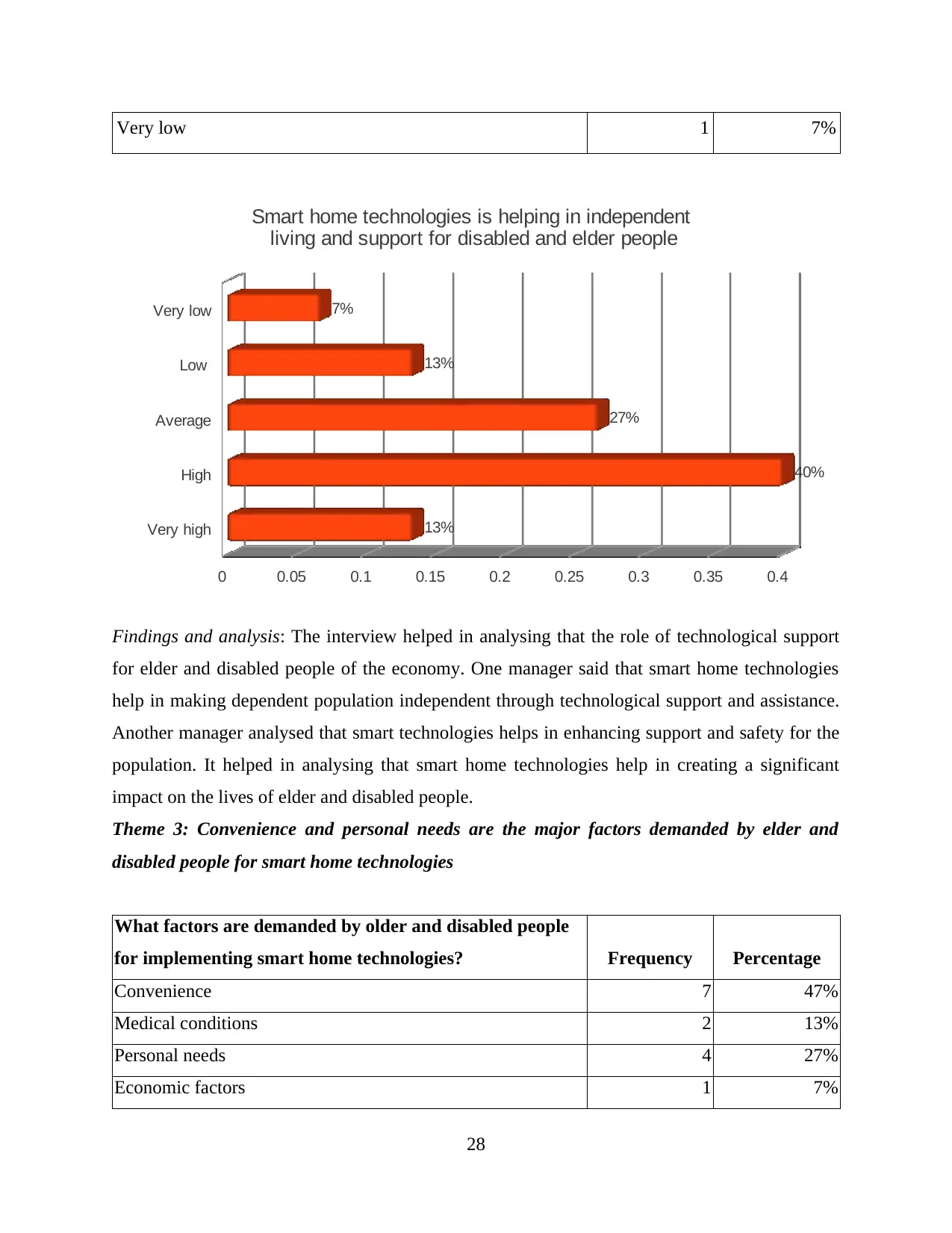
Very low 1 7%
Very high
High
Average
Low
Very low
0 0.05 0.1 0.15 0.2 0.25 0.3 0.35 0.4
13%
40%
27%
13%
7%
Smart home technologies is helping in independent
living and support for disabled and elder people
Findings and analysis: The interview helped in analysing that the role of technological support
for elder and disabled people of the economy. One manager said that smart home technologies
help in making dependent population independent through technological support and assistance.
Another manager analysed that smart technologies helps in enhancing support and safety for the
population. It helped in analysing that smart home technologies help in creating a significant
impact on the lives of elder and disabled people.
Theme 3: Convenience and personal needs are the major factors demanded by elder and
disabled people for smart home technologies
What factors are demanded by older and disabled people
for implementing smart home technologies? Frequency Percentage
Convenience 7 47%
Medical conditions 2 13%
Personal needs 4 27%
Economic factors 1 7%
28
Very high
High
Average
Low
Very low
0 0.05 0.1 0.15 0.2 0.25 0.3 0.35 0.4
13%
40%
27%
13%
7%
Smart home technologies is helping in independent
living and support for disabled and elder people
Findings and analysis: The interview helped in analysing that the role of technological support
for elder and disabled people of the economy. One manager said that smart home technologies
help in making dependent population independent through technological support and assistance.
Another manager analysed that smart technologies helps in enhancing support and safety for the
population. It helped in analysing that smart home technologies help in creating a significant
impact on the lives of elder and disabled people.
Theme 3: Convenience and personal needs are the major factors demanded by elder and
disabled people for smart home technologies
What factors are demanded by older and disabled people
for implementing smart home technologies? Frequency Percentage
Convenience 7 47%
Medical conditions 2 13%
Personal needs 4 27%
Economic factors 1 7%
28

Regular training 1 7%
47%
13%
27%
7%
7%
Convenience and personal needs are the major factors
demanded by elder and disabled people for smart home technologies
Convenience
Medical conditions
Personal needs
Economic factors
Regular training
Findings and analysis: On being asked about the factors which contributes in enhancing demand
for smart home technologies, manager stated that people seek for convenient and easy to use
technologies which involves low rate of complexity for the population. In addition to these
personal and individual needs of the employees also plays a significant role for the same. People
with different medical conditions prefer different technologies for their homes. Thus, the overall
analysis reflects that convenience and personal needs are the major factors demanded by elder
and disabled people for smart home technologies. For example an elder person facing mobility
issues demand automated lighting, curtain and bed system. Similarly, physically challenged
person demands for supportive technology as per his/her convenience as wheel chair, assertive
technology etc.
Theme 4: tele-health technologies are developing market demand in the economy
Findings and analysis: The concept of tele-health has been widely accepted in the economy to
create a definite impact on the demand for technological service demand. According to the
analysis the concept of tele-health has widely developed in the UK market. According to one of
the manager companies providing these services has analysed a considerable demand for the
same and the impact of these services has decreased the demand for medical care services. In
29
47%
13%
27%
7%
7%
Convenience and personal needs are the major factors
demanded by elder and disabled people for smart home technologies
Convenience
Medical conditions
Personal needs
Economic factors
Regular training
Findings and analysis: On being asked about the factors which contributes in enhancing demand
for smart home technologies, manager stated that people seek for convenient and easy to use
technologies which involves low rate of complexity for the population. In addition to these
personal and individual needs of the employees also plays a significant role for the same. People
with different medical conditions prefer different technologies for their homes. Thus, the overall
analysis reflects that convenience and personal needs are the major factors demanded by elder
and disabled people for smart home technologies. For example an elder person facing mobility
issues demand automated lighting, curtain and bed system. Similarly, physically challenged
person demands for supportive technology as per his/her convenience as wheel chair, assertive
technology etc.
Theme 4: tele-health technologies are developing market demand in the economy
Findings and analysis: The concept of tele-health has been widely accepted in the economy to
create a definite impact on the demand for technological service demand. According to the
analysis the concept of tele-health has widely developed in the UK market. According to one of
the manager companies providing these services has analysed a considerable demand for the
same and the impact of these services has decreased the demand for medical care services. In
29
Secure Best Marks with AI Grader
Need help grading? Try our AI Grader for instant feedback on your assignments.

addition, it was also stated by other manager that the impact of tele-health has affected the
medical support services and economic growth of the country. Hence, it can be analysed that
tele-health technologies are developing market demand in the economy.
Theme 5: Training and developing technological awareness within elder and disabled people
are the major challenges faced
What are the challenges faced to enhance the demand for
smart home technologies? Frequency Percentage
Resistance to change 1 7%
Financial issues 3 20%
Technological imparity 6 40%
Emotional factors 2 13%
Cultural factors 3 20%
Findings and analysis: The analysis helped in analysing that there are many challenges faced by
the industry to create a definite market position for smart services. One of the manager analysed
that acceptance is reluctant within old age and disabled population. Hence training them to use
the services in an effective manner is a challenging task for the companies. Moreover, another
30
7%
20%
40%
13%
20%
Technological imparity in elder and disabled people are
the major challenges faced
Resistance to change
Financial issues
Technological imparity
Emotional factors
Cultural factors
medical support services and economic growth of the country. Hence, it can be analysed that
tele-health technologies are developing market demand in the economy.
Theme 5: Training and developing technological awareness within elder and disabled people
are the major challenges faced
What are the challenges faced to enhance the demand for
smart home technologies? Frequency Percentage
Resistance to change 1 7%
Financial issues 3 20%
Technological imparity 6 40%
Emotional factors 2 13%
Cultural factors 3 20%
Findings and analysis: The analysis helped in analysing that there are many challenges faced by
the industry to create a definite market position for smart services. One of the manager analysed
that acceptance is reluctant within old age and disabled population. Hence training them to use
the services in an effective manner is a challenging task for the companies. Moreover, another
30
7%
20%
40%
13%
20%
Technological imparity in elder and disabled people are
the major challenges faced
Resistance to change
Financial issues
Technological imparity
Emotional factors
Cultural factors

manager analysed that developing awareness for smart home technologies within the population
is a challenging task for the companies as the promotional strategies demand high focus on
personal selling approach rather than mass media advertisement. Hence, training and developing
technological awareness within elder and disabled people are the major challenges faced by
companies providing smart home technologies.
31
is a challenging task for the companies as the promotional strategies demand high focus on
personal selling approach rather than mass media advertisement. Hence, training and developing
technological awareness within elder and disabled people are the major challenges faced by
companies providing smart home technologies.
31

CHAPTER 5 CONCLUSION AND RECOMMENDATION
5.1 Introduction
This section of the study focuses on developing a clear and in-depth understanding about
the overall research analysis and subject matter of the report. It provides a clear analysis of
research findings and analysis of the section. The present study focused on analysing the effect
of smart home technologies to support disabled and elderly people in UK. This section will
analyse the research findings and theoretical analysis to conclude the topic.
5.2 Conclusion
The overall research focused on understanding the concept of smart home technologies
and its and analysing the impact of the same on the elder and disabled population of UK. The
overall research analysed that smart home technologies is an emerging and well accepted
concept for the population of the country. People are widely accepting the services in order to
ensure safe and supportive living conditions. The smart home featured such as automation, safety
and support has helped in providing a convenient support to people. Moreover, the growth and
development of the sector has helped the companies in developing customized and cost effective
services for elder and disabled population. However, the issues regarding cost of technologies,
technological imparity, installation issues, individual need etc. are the major challenges for
companies and industry as well.
The findings of the research analysed that the impact and smart home services of elder
people is high and supportive. It has helped in providing them with effective support and
independence for carrying out their routine. The impact of changing demographic conditions
such as rising rate of life expectancy within population has helped in developing high demand
for smart technologies. Moreover, rising economic level of the people has also affected the
demand for acceptance of smart technologies and demand for the same. The findings of the
research helped in stating that economic and demographic factors contribute demand for smart
home technologies. In addition to this the smart home technologies has also contributed in
economic growth of the country because it has supported the medical demand and high growth
rate for the economy. There are many challenges which are being faced to enhance technological
support for elder and disabled people of UK. It includes developing technological awareness,
cost effectiveness and training need gap for the people.
32
5.1 Introduction
This section of the study focuses on developing a clear and in-depth understanding about
the overall research analysis and subject matter of the report. It provides a clear analysis of
research findings and analysis of the section. The present study focused on analysing the effect
of smart home technologies to support disabled and elderly people in UK. This section will
analyse the research findings and theoretical analysis to conclude the topic.
5.2 Conclusion
The overall research focused on understanding the concept of smart home technologies
and its and analysing the impact of the same on the elder and disabled population of UK. The
overall research analysed that smart home technologies is an emerging and well accepted
concept for the population of the country. People are widely accepting the services in order to
ensure safe and supportive living conditions. The smart home featured such as automation, safety
and support has helped in providing a convenient support to people. Moreover, the growth and
development of the sector has helped the companies in developing customized and cost effective
services for elder and disabled population. However, the issues regarding cost of technologies,
technological imparity, installation issues, individual need etc. are the major challenges for
companies and industry as well.
The findings of the research analysed that the impact and smart home services of elder
people is high and supportive. It has helped in providing them with effective support and
independence for carrying out their routine. The impact of changing demographic conditions
such as rising rate of life expectancy within population has helped in developing high demand
for smart technologies. Moreover, rising economic level of the people has also affected the
demand for acceptance of smart technologies and demand for the same. The findings of the
research helped in stating that economic and demographic factors contribute demand for smart
home technologies. In addition to this the smart home technologies has also contributed in
economic growth of the country because it has supported the medical demand and high growth
rate for the economy. There are many challenges which are being faced to enhance technological
support for elder and disabled people of UK. It includes developing technological awareness,
cost effectiveness and training need gap for the people.
32
Paraphrase This Document
Need a fresh take? Get an instant paraphrase of this document with our AI Paraphraser

The findings of the research reflected that technological advancement has a definite
impact on this group of people however need of training and development in the economy is
high. Demand for advanced technology such as sensitivity alarm or security and monitoring has
not developed widely in this segment. Older and disabled group seek for services which may
help them in enhancing their efficiency and growth in the market. Training and developing
technological awareness within elder and disabled people are the major challenges faced by
companies providing smart home technologies.
5.3 Recommendation to government and companies providing smart home services
The overall research helped in effectively analysing that the concept of smart home
technologies is effective for the economic development of the country to support independent
living of the elder and disabled people as well. Companies are developing effective measures to
support and meet the needs of the consumers for the same. In addition to this, the demand for
effective training, development and acceptance within the market is also significant for the
economy. Psychological barrier among people is also a crucial challenge which may create a
social impact on the acceptance of the concept. This reveals that older people’s acceptance of
assertive home-based technology is dependent on the complex relationships between cognitive,
affective and emotional components. Hence, the companies must focus on providing cost
effective and customised needs of the people in order to effectively help in attaining their
requirements. Moreover, developing convenient and easy services is one another significant
factor for enhancing growth prospect for the employees. High and social promotion within the
economy is also important for enhancing growth prospects for the people.
33
impact on this group of people however need of training and development in the economy is
high. Demand for advanced technology such as sensitivity alarm or security and monitoring has
not developed widely in this segment. Older and disabled group seek for services which may
help them in enhancing their efficiency and growth in the market. Training and developing
technological awareness within elder and disabled people are the major challenges faced by
companies providing smart home technologies.
5.3 Recommendation to government and companies providing smart home services
The overall research helped in effectively analysing that the concept of smart home
technologies is effective for the economic development of the country to support independent
living of the elder and disabled people as well. Companies are developing effective measures to
support and meet the needs of the consumers for the same. In addition to this, the demand for
effective training, development and acceptance within the market is also significant for the
economy. Psychological barrier among people is also a crucial challenge which may create a
social impact on the acceptance of the concept. This reveals that older people’s acceptance of
assertive home-based technology is dependent on the complex relationships between cognitive,
affective and emotional components. Hence, the companies must focus on providing cost
effective and customised needs of the people in order to effectively help in attaining their
requirements. Moreover, developing convenient and easy services is one another significant
factor for enhancing growth prospect for the employees. High and social promotion within the
economy is also important for enhancing growth prospects for the people.
33

REFERENCES
Books and journals
Alam, M.R., Reaz, M.B.I. and Ali, M.A.M., 2012. A review of smart homes—Past, present, and
future. Systems, Man, and Cybernetics, Part C: Applications and Reviews, IEEE
Transactions on. 42(6). pp.1190-1203.
Baig, M.M. and Gholamhosseini, H., 2013. Smart health monitoring systems: an overview of
design and modeling. Journal of medical systems. 37(2). pp.1-14.
Balta-Ozkan, N. and et.al., 2013. Social barriers to the adoption of smart homes. Energy Policy.
63. pp.363-374.
Chan, M. and et.al., 2012. Smart wearable systems: Current status and future challenges.
Artificial intelligence in medicine. 56(3). pp.137-156.
Chen, L., Nugent, C.D. and Wang, H., 2012. A knowledge-driven approach to activity
recognition in smart homes. Knowledge and Data Engineering, IEEE Transactions on.
24(6). pp.961-974.
De Silva, L.C., Morikawa, C. and Petra, I.M., 2012. State of the art of smart homes. Engineering
Applications of Artificial Intelligence. 25(7). pp.1313-1321.
Domingo, M.C., 2012. An overview of the Internet of Things for people with disabilities.
Journal of Network and Computer Applications. 35(2). pp.584-596.
Flick, U., 2015. Introducing research methodology: A beginner's guide to doing a research
project. Sage.
Gast, D. L. and Ledford, J. R., 2014. Single case research methodology: Applications in special
education and behavioral sciences. Routledge.
GhaffarianHoseini, A. and et.al., 2013. The essence of future smart houses: From embedding
ICT to adapting to sustainability principles. Renewable and Sustainable Energy Reviews.
24. pp.593-607.
Gowda, A. N. and et.al., 2013. Control4 Smart Home System using LabVIEW. International
Journal of Engineering Science and Innovative Technology (IJESIT) ISSN. pp. 2319-
5967.
Heart, T. and Kalderon, E., 2013. Older adults: are they ready to adopt health-related ICT?.
International journal of medical informatics. 82(11). pp.e209-e231.
Hofmann, B., 2013. Ethical challenges with welfare technology: a review of the literature.
Science and engineering ethics. 19(2). pp.389-406.
34
Books and journals
Alam, M.R., Reaz, M.B.I. and Ali, M.A.M., 2012. A review of smart homes—Past, present, and
future. Systems, Man, and Cybernetics, Part C: Applications and Reviews, IEEE
Transactions on. 42(6). pp.1190-1203.
Baig, M.M. and Gholamhosseini, H., 2013. Smart health monitoring systems: an overview of
design and modeling. Journal of medical systems. 37(2). pp.1-14.
Balta-Ozkan, N. and et.al., 2013. Social barriers to the adoption of smart homes. Energy Policy.
63. pp.363-374.
Chan, M. and et.al., 2012. Smart wearable systems: Current status and future challenges.
Artificial intelligence in medicine. 56(3). pp.137-156.
Chen, L., Nugent, C.D. and Wang, H., 2012. A knowledge-driven approach to activity
recognition in smart homes. Knowledge and Data Engineering, IEEE Transactions on.
24(6). pp.961-974.
De Silva, L.C., Morikawa, C. and Petra, I.M., 2012. State of the art of smart homes. Engineering
Applications of Artificial Intelligence. 25(7). pp.1313-1321.
Domingo, M.C., 2012. An overview of the Internet of Things for people with disabilities.
Journal of Network and Computer Applications. 35(2). pp.584-596.
Flick, U., 2015. Introducing research methodology: A beginner's guide to doing a research
project. Sage.
Gast, D. L. and Ledford, J. R., 2014. Single case research methodology: Applications in special
education and behavioral sciences. Routledge.
GhaffarianHoseini, A. and et.al., 2013. The essence of future smart houses: From embedding
ICT to adapting to sustainability principles. Renewable and Sustainable Energy Reviews.
24. pp.593-607.
Gowda, A. N. and et.al., 2013. Control4 Smart Home System using LabVIEW. International
Journal of Engineering Science and Innovative Technology (IJESIT) ISSN. pp. 2319-
5967.
Heart, T. and Kalderon, E., 2013. Older adults: are they ready to adopt health-related ICT?.
International journal of medical informatics. 82(11). pp.e209-e231.
Hofmann, B., 2013. Ethical challenges with welfare technology: a review of the literature.
Science and engineering ethics. 19(2). pp.389-406.
34
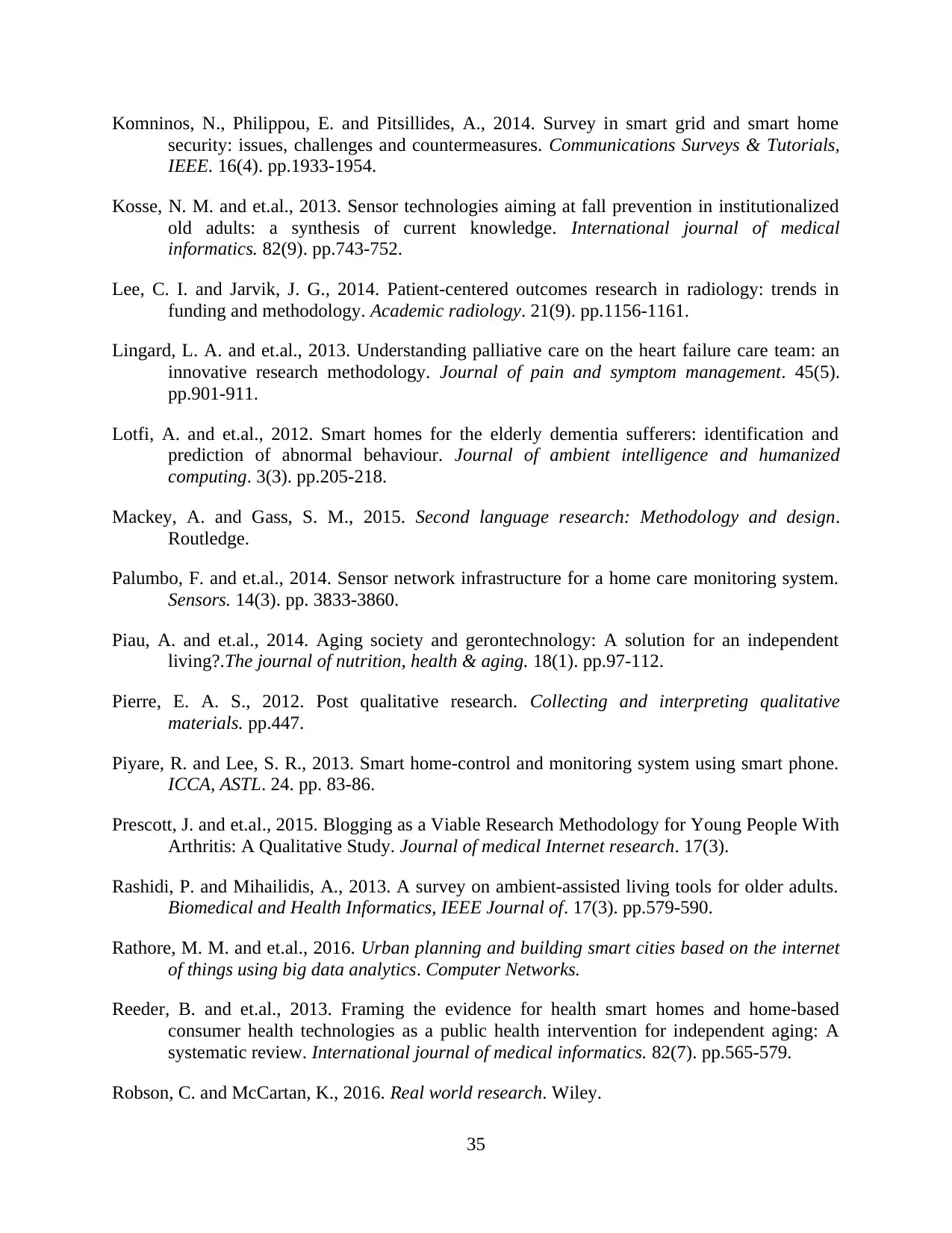
Komninos, N., Philippou, E. and Pitsillides, A., 2014. Survey in smart grid and smart home
security: issues, challenges and countermeasures. Communications Surveys & Tutorials,
IEEE. 16(4). pp.1933-1954.
Kosse, N. M. and et.al., 2013. Sensor technologies aiming at fall prevention in institutionalized
old adults: a synthesis of current knowledge. International journal of medical
informatics. 82(9). pp.743-752.
Lee, C. I. and Jarvik, J. G., 2014. Patient-centered outcomes research in radiology: trends in
funding and methodology. Academic radiology. 21(9). pp.1156-1161.
Lingard, L. A. and et.al., 2013. Understanding palliative care on the heart failure care team: an
innovative research methodology. Journal of pain and symptom management. 45(5).
pp.901-911.
Lotfi, A. and et.al., 2012. Smart homes for the elderly dementia sufferers: identification and
prediction of abnormal behaviour. Journal of ambient intelligence and humanized
computing. 3(3). pp.205-218.
Mackey, A. and Gass, S. M., 2015. Second language research: Methodology and design.
Routledge.
Palumbo, F. and et.al., 2014. Sensor network infrastructure for a home care monitoring system.
Sensors. 14(3). pp. 3833-3860.
Piau, A. and et.al., 2014. Aging society and gerontechnology: A solution for an independent
living?.The journal of nutrition, health & aging. 18(1). pp.97-112.
Pierre, E. A. S., 2012. Post qualitative research. Collecting and interpreting qualitative
materials. pp.447.
Piyare, R. and Lee, S. R., 2013. Smart home-control and monitoring system using smart phone.
ICCA, ASTL. 24. pp. 83-86.
Prescott, J. and et.al., 2015. Blogging as a Viable Research Methodology for Young People With
Arthritis: A Qualitative Study. Journal of medical Internet research. 17(3).
Rashidi, P. and Mihailidis, A., 2013. A survey on ambient-assisted living tools for older adults.
Biomedical and Health Informatics, IEEE Journal of. 17(3). pp.579-590.
Rathore, M. M. and et.al., 2016. Urban planning and building smart cities based on the internet
of things using big data analytics. Computer Networks.
Reeder, B. and et.al., 2013. Framing the evidence for health smart homes and home-based
consumer health technologies as a public health intervention for independent aging: A
systematic review. International journal of medical informatics. 82(7). pp.565-579.
Robson, C. and McCartan, K., 2016. Real world research. Wiley.
35
security: issues, challenges and countermeasures. Communications Surveys & Tutorials,
IEEE. 16(4). pp.1933-1954.
Kosse, N. M. and et.al., 2013. Sensor technologies aiming at fall prevention in institutionalized
old adults: a synthesis of current knowledge. International journal of medical
informatics. 82(9). pp.743-752.
Lee, C. I. and Jarvik, J. G., 2014. Patient-centered outcomes research in radiology: trends in
funding and methodology. Academic radiology. 21(9). pp.1156-1161.
Lingard, L. A. and et.al., 2013. Understanding palliative care on the heart failure care team: an
innovative research methodology. Journal of pain and symptom management. 45(5).
pp.901-911.
Lotfi, A. and et.al., 2012. Smart homes for the elderly dementia sufferers: identification and
prediction of abnormal behaviour. Journal of ambient intelligence and humanized
computing. 3(3). pp.205-218.
Mackey, A. and Gass, S. M., 2015. Second language research: Methodology and design.
Routledge.
Palumbo, F. and et.al., 2014. Sensor network infrastructure for a home care monitoring system.
Sensors. 14(3). pp. 3833-3860.
Piau, A. and et.al., 2014. Aging society and gerontechnology: A solution for an independent
living?.The journal of nutrition, health & aging. 18(1). pp.97-112.
Pierre, E. A. S., 2012. Post qualitative research. Collecting and interpreting qualitative
materials. pp.447.
Piyare, R. and Lee, S. R., 2013. Smart home-control and monitoring system using smart phone.
ICCA, ASTL. 24. pp. 83-86.
Prescott, J. and et.al., 2015. Blogging as a Viable Research Methodology for Young People With
Arthritis: A Qualitative Study. Journal of medical Internet research. 17(3).
Rashidi, P. and Mihailidis, A., 2013. A survey on ambient-assisted living tools for older adults.
Biomedical and Health Informatics, IEEE Journal of. 17(3). pp.579-590.
Rathore, M. M. and et.al., 2016. Urban planning and building smart cities based on the internet
of things using big data analytics. Computer Networks.
Reeder, B. and et.al., 2013. Framing the evidence for health smart homes and home-based
consumer health technologies as a public health intervention for independent aging: A
systematic review. International journal of medical informatics. 82(7). pp.565-579.
Robson, C. and McCartan, K., 2016. Real world research. Wiley.
35
Secure Best Marks with AI Grader
Need help grading? Try our AI Grader for instant feedback on your assignments.

Röcker, C., 2012. Smart medical services: a discussion of state-of-the-art approaches.
International Journal of Machine Learning and Computing. 2(3). p p.226.
Rosenberg, L., Kottorp, A. and Nygård, L., 2012. Readiness for technology use with people with
dementia the perspectives of significant others. Journal of Applied Gerontology. 31(4).
pp.510-530.
Sixsmith, A., 2013. Technology and the Challenge of Aging. In Technologies for Active Aging
(pp. 7-25). Springer US.
Suryadevara, N.K. and et.al., 2012. Wireless sensors network based safe home to care elderly
people: behaviour detection. Sensors and Actuators A: Physical. 186. pp.277-283.
Suryadevara, N.K. and Mukhopadhyay, S.C., 2012. Wireless sensor network based home
monitoring system for wellness determination of elderly.Sensors Journal, IEEE. 12(6).
pp.1965-1972.
Taylor, S. J., Bogdan, R. and DeVault, M., 2015. Introduction to qualitative research methods: A
guidebook and resource. John Wiley & Sons.
Ward, G. and et.al., 2012. Fall detectors: a review of the literature. Journal of Assistive
Technologies. 6(3). pp.202-215.
Zwijsen, S.A., Niemeijer, A.R. and Hertogh, C.M., 2011. Ethics of using assistive technology in
the care for community-dwelling elderly people: An overview of the literature. Aging &
mental health.15(4). pp.419-427.
Online
Best Smart Home Gadgets of 2016. 2016. [Online]. Available through:
<http://www.tomsguide.com/us/best-smart-home-gadgets,review-2008.html>.
[Accessed on 26th
April 2016].
WHAT IS A SMART HOME. 2016. [Online]. Available through:
<http://www.smarthomeusa.com/smarthome/>. [Accessed on 26th
April 2016].
Advantages of a Smart Home. 2016. [Online]. Available through:
<https://www.directenergy.com/learning-center/modern-home/advantages-smart-
home>. [Accessed on 26th
April 2016].
Analysis of UK long term care market. 2016. [Online]. Available through:
<https://connect.innovateuk.org/documents/3301954/11214094/Health_KTN_LongTerm
Care_Frost%26Sullivan_report.pdf/167cff1d-020f-4dcb-a2b6-0610238c7d29>.
[Accessed on 26th
April 2016].
36
International Journal of Machine Learning and Computing. 2(3). p p.226.
Rosenberg, L., Kottorp, A. and Nygård, L., 2012. Readiness for technology use with people with
dementia the perspectives of significant others. Journal of Applied Gerontology. 31(4).
pp.510-530.
Sixsmith, A., 2013. Technology and the Challenge of Aging. In Technologies for Active Aging
(pp. 7-25). Springer US.
Suryadevara, N.K. and et.al., 2012. Wireless sensors network based safe home to care elderly
people: behaviour detection. Sensors and Actuators A: Physical. 186. pp.277-283.
Suryadevara, N.K. and Mukhopadhyay, S.C., 2012. Wireless sensor network based home
monitoring system for wellness determination of elderly.Sensors Journal, IEEE. 12(6).
pp.1965-1972.
Taylor, S. J., Bogdan, R. and DeVault, M., 2015. Introduction to qualitative research methods: A
guidebook and resource. John Wiley & Sons.
Ward, G. and et.al., 2012. Fall detectors: a review of the literature. Journal of Assistive
Technologies. 6(3). pp.202-215.
Zwijsen, S.A., Niemeijer, A.R. and Hertogh, C.M., 2011. Ethics of using assistive technology in
the care for community-dwelling elderly people: An overview of the literature. Aging &
mental health.15(4). pp.419-427.
Online
Best Smart Home Gadgets of 2016. 2016. [Online]. Available through:
<http://www.tomsguide.com/us/best-smart-home-gadgets,review-2008.html>.
[Accessed on 26th
April 2016].
WHAT IS A SMART HOME. 2016. [Online]. Available through:
<http://www.smarthomeusa.com/smarthome/>. [Accessed on 26th
April 2016].
Advantages of a Smart Home. 2016. [Online]. Available through:
<https://www.directenergy.com/learning-center/modern-home/advantages-smart-
home>. [Accessed on 26th
April 2016].
Analysis of UK long term care market. 2016. [Online]. Available through:
<https://connect.innovateuk.org/documents/3301954/11214094/Health_KTN_LongTerm
Care_Frost%26Sullivan_report.pdf/167cff1d-020f-4dcb-a2b6-0610238c7d29>.
[Accessed on 26th
April 2016].
36
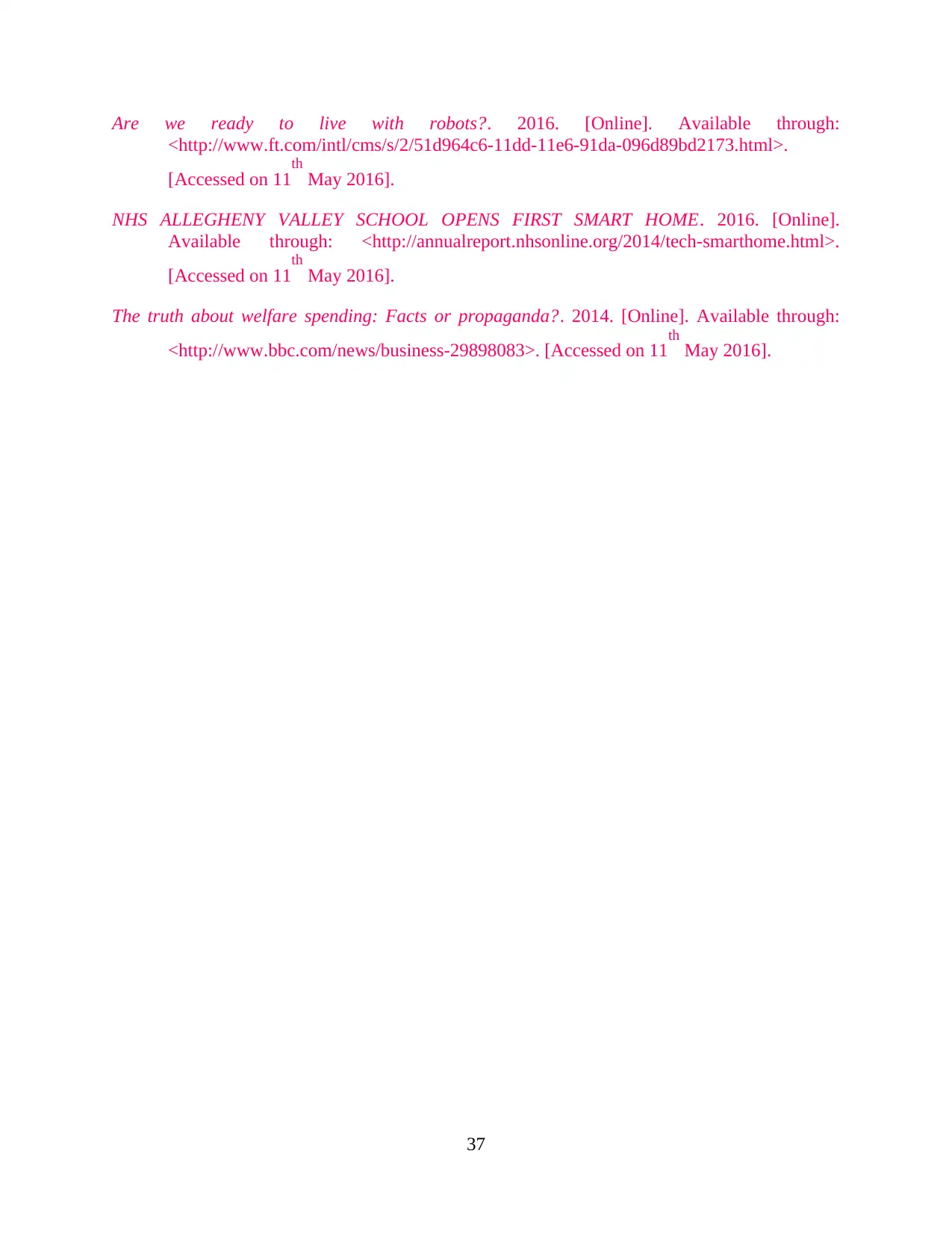
Are we ready to live with robots?. 2016. [Online]. Available through:
<http://www.ft.com/intl/cms/s/2/51d964c6-11dd-11e6-91da-096d89bd2173.html>.
[Accessed on 11th
May 2016].
NHS ALLEGHENY VALLEY SCHOOL OPENS FIRST SMART HOME. 2016. [Online].
Available through: <http://annualreport.nhsonline.org/2014/tech-smarthome.html>.
[Accessed on 11th
May 2016].
The truth about welfare spending: Facts or propaganda?. 2014. [Online]. Available through:
<http://www.bbc.com/news/business-29898083>. [Accessed on 11th
May 2016].
37
<http://www.ft.com/intl/cms/s/2/51d964c6-11dd-11e6-91da-096d89bd2173.html>.
[Accessed on 11th
May 2016].
NHS ALLEGHENY VALLEY SCHOOL OPENS FIRST SMART HOME. 2016. [Online].
Available through: <http://annualreport.nhsonline.org/2014/tech-smarthome.html>.
[Accessed on 11th
May 2016].
The truth about welfare spending: Facts or propaganda?. 2014. [Online]. Available through:
<http://www.bbc.com/news/business-29898083>. [Accessed on 11th
May 2016].
37

APPENDIX
A1. Disability information
There are 11 million people in UK who are suffering from total or partial disability which
includes long term illness, impairment or disability, impairments are those that affect mobility,
lifting or carrying etc. Around 6% of children are disabled, compared to 16% of working age
adults and 45% of adults over State Pension age.
A2. Questionnaire for consumers
Name:
Age:
Gender:
Disability if Any:
Are you using smart home technologies in your homes ?
Yes
No
Do you think smart home technologies supports you in independent living?
Definitely
Yes
Not sure
To some extent
Not at all
Are you conformable with the technology based smart home services?
Definitely
Yes
To some extent
Not sure
Not at all
38
A1. Disability information
There are 11 million people in UK who are suffering from total or partial disability which
includes long term illness, impairment or disability, impairments are those that affect mobility,
lifting or carrying etc. Around 6% of children are disabled, compared to 16% of working age
adults and 45% of adults over State Pension age.
A2. Questionnaire for consumers
Name:
Age:
Gender:
Disability if Any:
Are you using smart home technologies in your homes ?
Yes
No
Do you think smart home technologies supports you in independent living?
Definitely
Yes
Not sure
To some extent
Not at all
Are you conformable with the technology based smart home services?
Definitely
Yes
To some extent
Not sure
Not at all
38
Paraphrase This Document
Need a fresh take? Get an instant paraphrase of this document with our AI Paraphraser
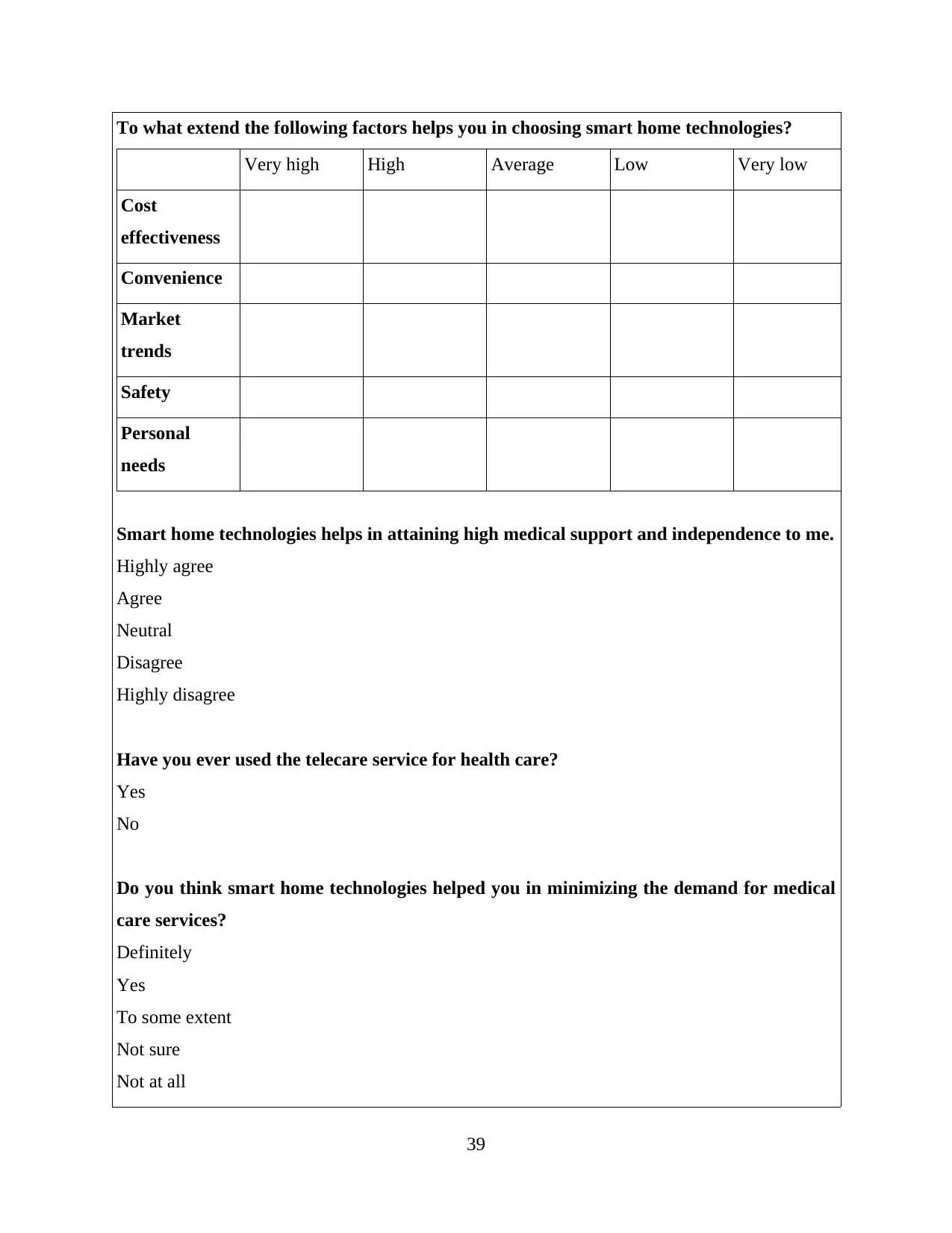
To what extend the following factors helps you in choosing smart home technologies?
Very high High Average Low Very low
Cost
effectiveness
Convenience
Market
trends
Safety
Personal
needs
Smart home technologies helps in attaining high medical support and independence to me.
Highly agree
Agree
Neutral
Disagree
Highly disagree
Have you ever used the telecare service for health care?
Yes
No
Do you think smart home technologies helped you in minimizing the demand for medical
care services?
Definitely
Yes
To some extent
Not sure
Not at all
39
Very high High Average Low Very low
Cost
effectiveness
Convenience
Market
trends
Safety
Personal
needs
Smart home technologies helps in attaining high medical support and independence to me.
Highly agree
Agree
Neutral
Disagree
Highly disagree
Have you ever used the telecare service for health care?
Yes
No
Do you think smart home technologies helped you in minimizing the demand for medical
care services?
Definitely
Yes
To some extent
Not sure
Not at all
39
1 out of 44
Related Documents
Your All-in-One AI-Powered Toolkit for Academic Success.
+13062052269
info@desklib.com
Available 24*7 on WhatsApp / Email
![[object Object]](/_next/static/media/star-bottom.7253800d.svg)
Unlock your academic potential
© 2024 | Zucol Services PVT LTD | All rights reserved.





